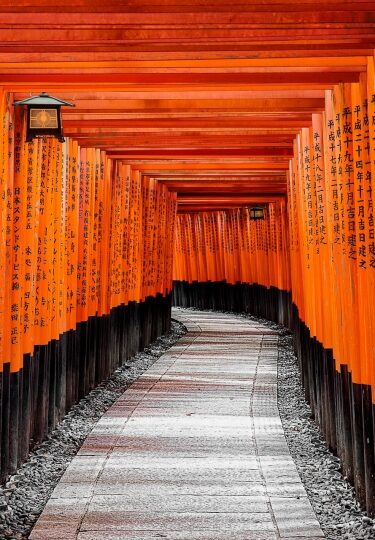Self-isolated for years, Japan retains ways of doing things that set it apart. That difference has helped make it attractive to artists for a century or more.
Its landmark wonders have become familiar to us all through countless photos, paintings, films and TV shows. Whether you have been to Japan or not, you will recognize many of those beautiful sights.
This list of the most famous Japanese landmarks spans a range from ancient castles to natural wonders and the world’s busiest pedestrian crossing. Inspiration, perhaps, to visit this most fascinating of countries.
Arashiyama Bamboo Grove, Kyoto
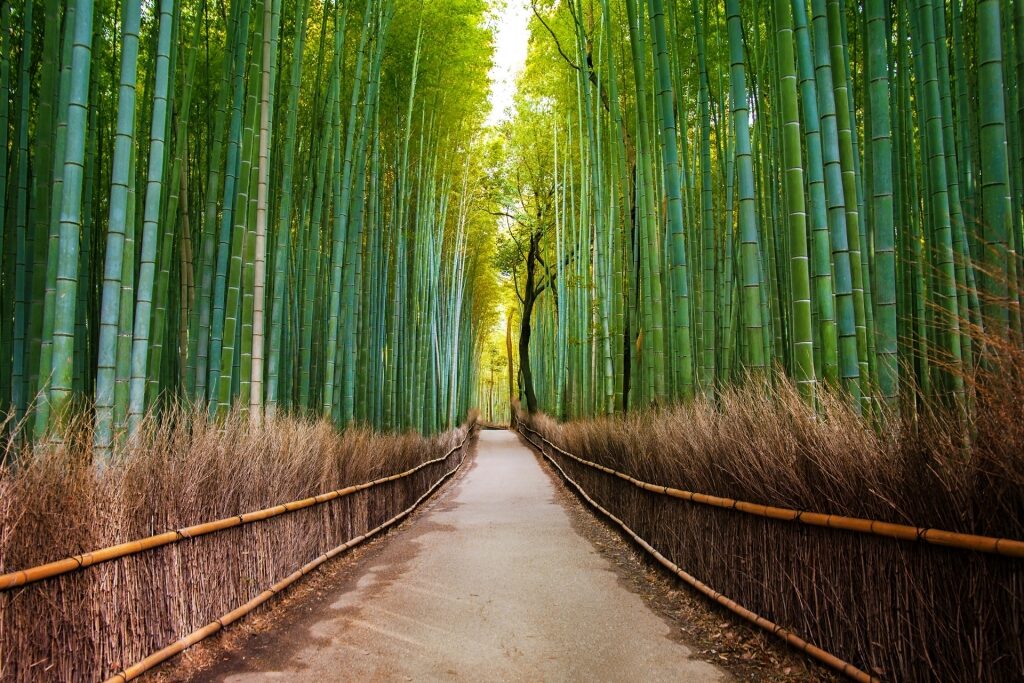
Arashiyama Bamboo Grove, Kyoto
The green bamboo of Arashiyama, swaying in a gentle breeze, is a hypnotic sight. No wonder this serene, shady forest, one of the best places to visit in Japan, has captured the imagination of poets and artists for hundreds of years. There’s almost perfect symmetry as you wander along the path, almost impossibly tall, slender bamboos arching gracefully overhead.
The Arashiyama Mountains are a scenic area on the western outskirts of Kyoto. It’s a popular area for hiking and cycling, with trails running through the bamboo forest.
The grove is outside Tenryuji, a Buddhist temple established in 1339. That took the place of a ninth century one that was Japan’s first Zen temple.
Another nearby landmark is the scenic Togetsukyo (“Moon Crossing Bridge”) which originally dated to 836. There are a number of souvenir shops on the bridge and rickshaw rides are a popular way to cross it.
Dōtonbori, Osaka

Dōtonbori, Osaka
Dōtonbori is the shopping district at the heart of modern Osaka. A sea of neon signage and modern buildings, its most famous sight is the giant running Glico Man breasting a tape.
This flashing neon logo for a food company has been a symbol of this Japanese city since the 1940s. It was the first large advert restored after the destruction of World War II.

Dōtonbori, Osaka
Nearby is the pedestrianized Ebisubashi (Ebisu Bridge), Osaka’s equivalent of Times Square or Piccadilly Circus. Ebisubashi links two large shopping areas and, like Times Square, is a fascinating place to people-watch. Another Osaka landmark nearby is the massive red claw-waving crab over the Kani-Doraku restaurant.
Machiya, Kyoto
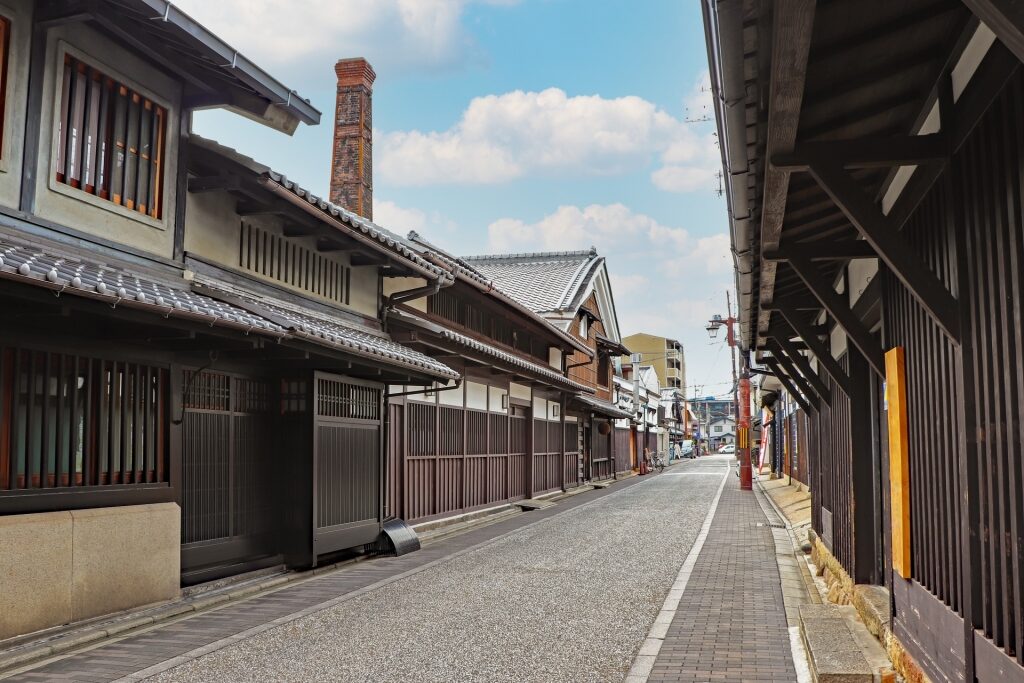
Machiya, Kyoto
Machiya (“town houses”) are the traditional 19th-century wooden houses of Japan, built long and narrow, as tax was paid on street frontage then. They were the homes, shops or workshops of merchants and wealthy artisans.
Kyoto, spared by World War II bombing, is lucky enough to have about 10,000 machiya left. They are very familiar from the city’s Gion and Pontocho geisha districts.
Kyoto is cold in winter and humid in summer, so “Kyomachiya” (Kyoto machiya) have layers of sliding doors to help adjust internal temperatures. Garden courtyards also help bring light into the long interiors.
Their recognition as a visitor attraction has boosted the ongoing restoration of machiya with traditional techniques. Many have been turned into restaurants, shops and even hotels and offer a wonderful insight into Japan’s more recent history.
Itsukushima Shrine, Hiroshima
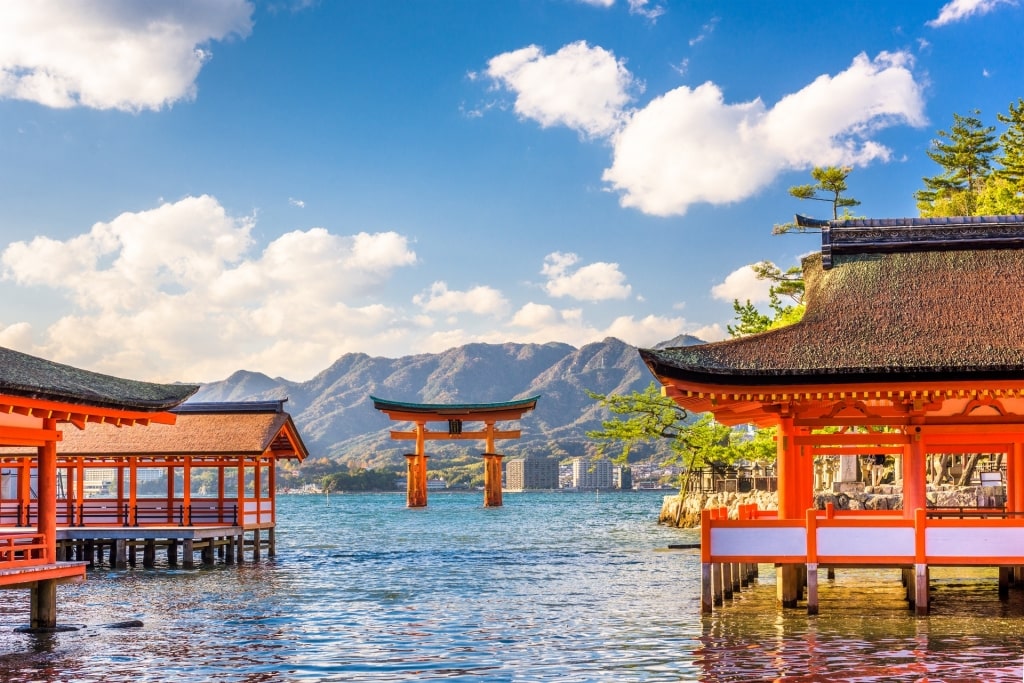
Itsukushima Shrine, Hiroshima
Shinto shrines have a great affinity to water, and the “floating” torii gate of Itsukushima is a picturesque and remarkable sight. Fifty feet tall, the scarlet gate seems to float on the sea at high tide.
The shrine is in the sea off Miyajima Island in Hiroshima Bay. As one of the most beautiful torii gates in Japan, it has been a popular subject for Japanese artists for centuries.
Its pillars are made of camphor wood, topped with cypress bark. The current torii dates to 1875 and takes the form of a wooden box weighted down with stones.
Now a Unesco World Heritage Site, the shrine is one of Japan’s National Treasures. It is dedicated to three Shinto deities who protect the imperial family, protect Japan and safeguard seafarers.
Senso-ji, Tokyo
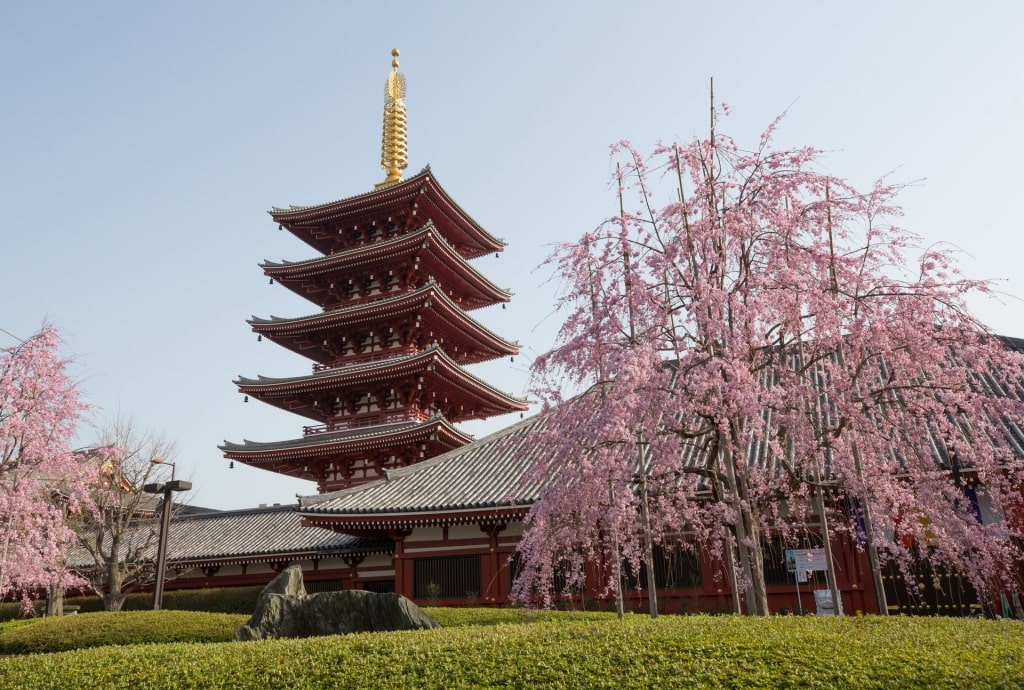
Senso-ji, Tokyo
The capital’s oldest Buddhist temple dates to 645 AD. Its red pillars and five-story pagoda are a must-see for visitors.
The approach street of Nakamise-dori was once a place to buy temple offerings. Now its shops and stalls trade in a wide range of Japanese souvenirs and tasty snacks.
The main entrance is the Kaminari-mon (“Thunder Gate”), identified by a 13-ft-tall red-paper lantern. It is flanked by the gods of thunder and wind.
The Hozo-mon (“Treasure-House Gate”), with its three lanterns, takes you into the inner temple. Here, it’s traditional to bathe yourself in incense from the giant bronze burner.
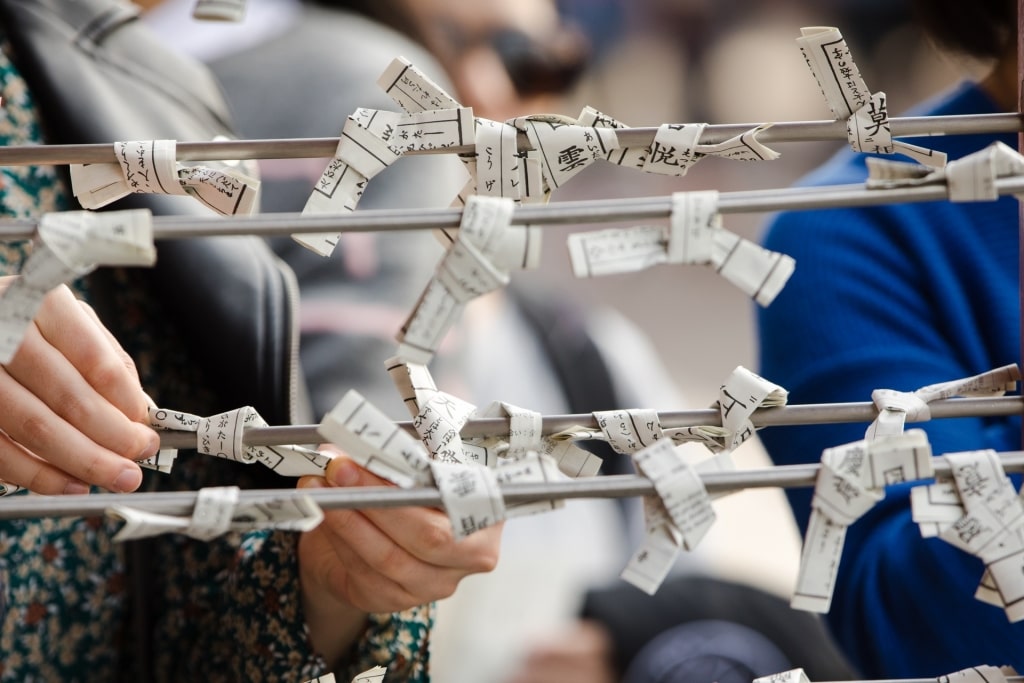
O-mikuji stall
You can also have your fortune told at an o-mikuji stall, or just find a quiet corner to take in the full experience. Amid the crowds, many people still come here to pray in what is still an active temple.
Osaka Castle, Osaka
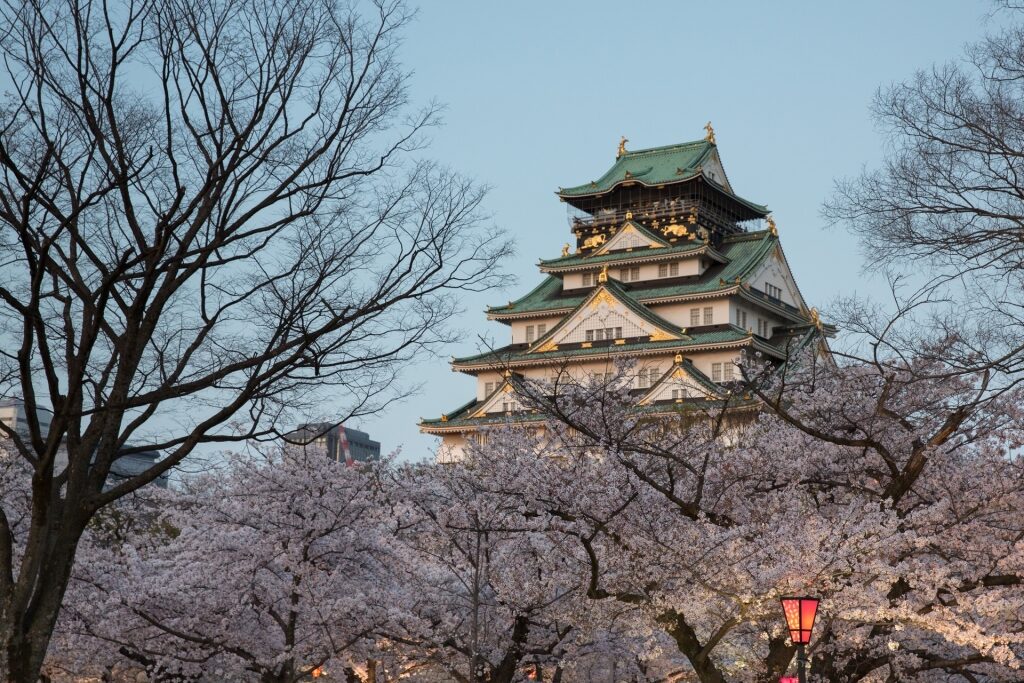
Osaka Castle, Osaka
Visible from much of the city, the five-story tower of Osaka Castle is a striking landmark. The ornate structure Osaka is known for is not all it seems, however.
Built in 1583, the castle has had to be restored many times since, following events such as sieges or lightning strikes. Now with a concrete core, it remains a faithful copy of the traditional design.
The ornate roof is covered with gold leaf and gold tigers, a showcase of wealth to intimidate the enemy. The eight giant golden fish with tiger heads, perched on the eaves, were a symbol of protection against fire.
Inside, a museum gives the history of the building and you can enjoy good views across Osaka. There are 13 other historic buildings within the castle grounds.
Shibuya Crossing, Tokyo
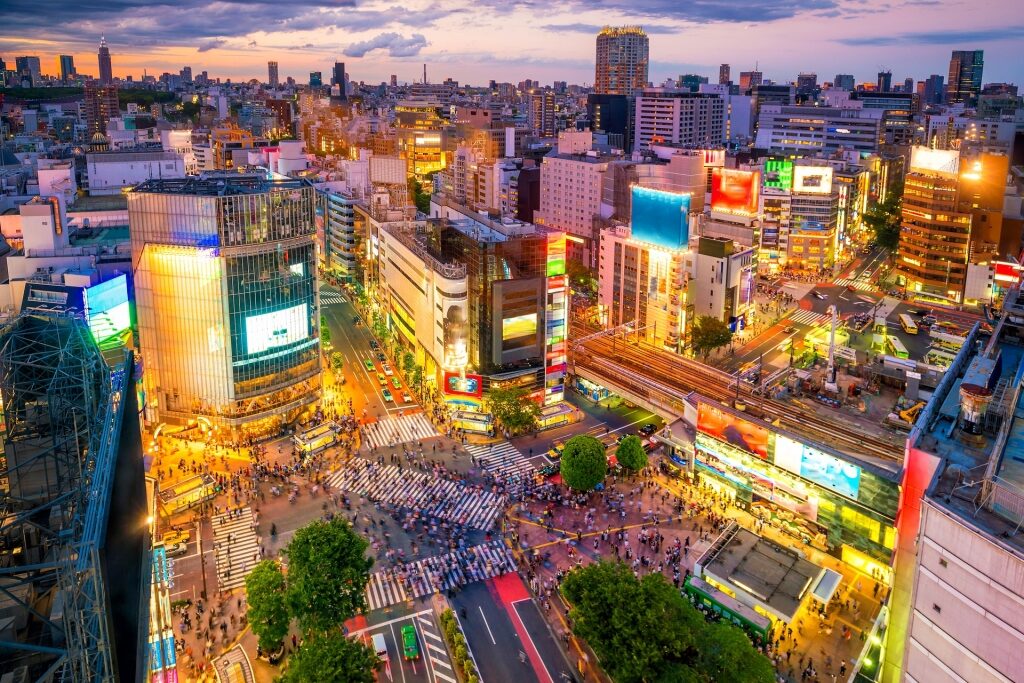
Shibuya Crossing, Tokyo
One of the most famous sights in the world, never mind Japan, Shibuya sees more than 1,000 people cross with every light change. It is the world’s busiest pedestrian crossing and an unmissable sight for any new Tokyo visitor.
Pedestrians converge from five different crossings during every two minute cycle. It’s a mesmerizing sight and it’s very Japanese that so many people could do it at once with such politeness and self-discipline.
Giant video screens on the canyon of skyscrapers around add to the spectacle. The best viewing point is the Starbucks outlet high above the crossing, the company’s highest branch in the world.
During rain showers, the crowd of pedestrian flowers with multicolored umbrellas. When this happens, the crossing becomes an even more photogenic sight.
Mount Fuji, Shimizu
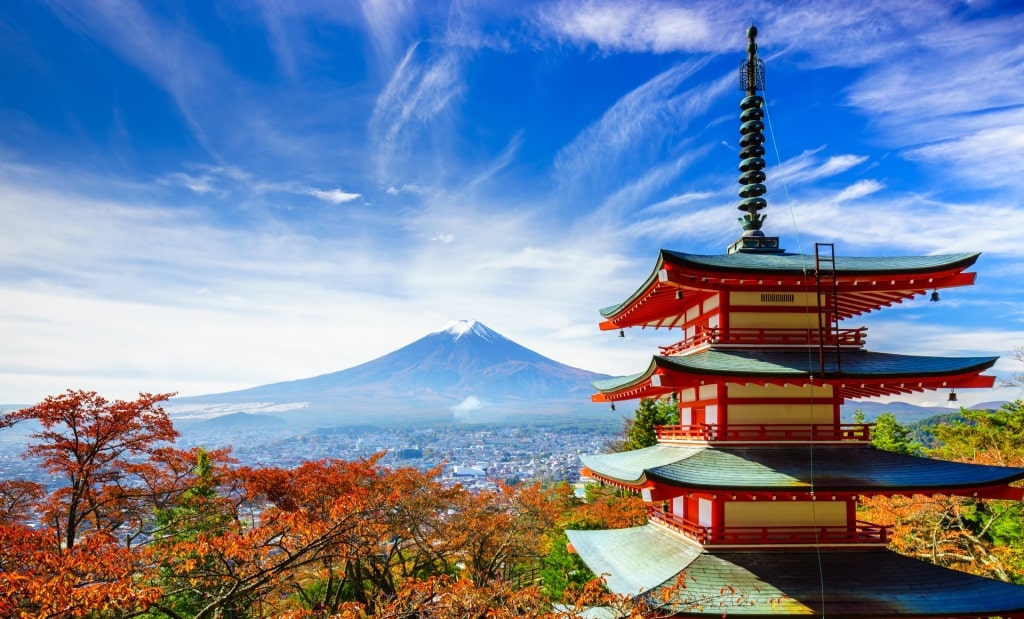
Mount Fuji, Shimizu
No list of Japan landmarks would be complete without Mount Fuji, whose image fills paintings, photos and posters in every souvenir shop. Its near-perfect cone, the tallest peak in Japan, looks even lovelier topped with snow in winter.
One of the best places to see it is Oshino Hakkai, once a point to start a pilgrimage up the sacred Japanese mountain. It has eight ponds, eight being a significant number in Buddhism, which are fed by water from the mountain’s snow.
In summer, the climb to the 12,380-ft summit attracts thousands of hikers. Many start at night just to see the sunrise here. This sunrise, in the “Land of the Rising Sun”, is very special. Called “Goraiko” (Great Sunrise), it’s something many Japanese wish to experience once.
Himeji Castle, Kyoto
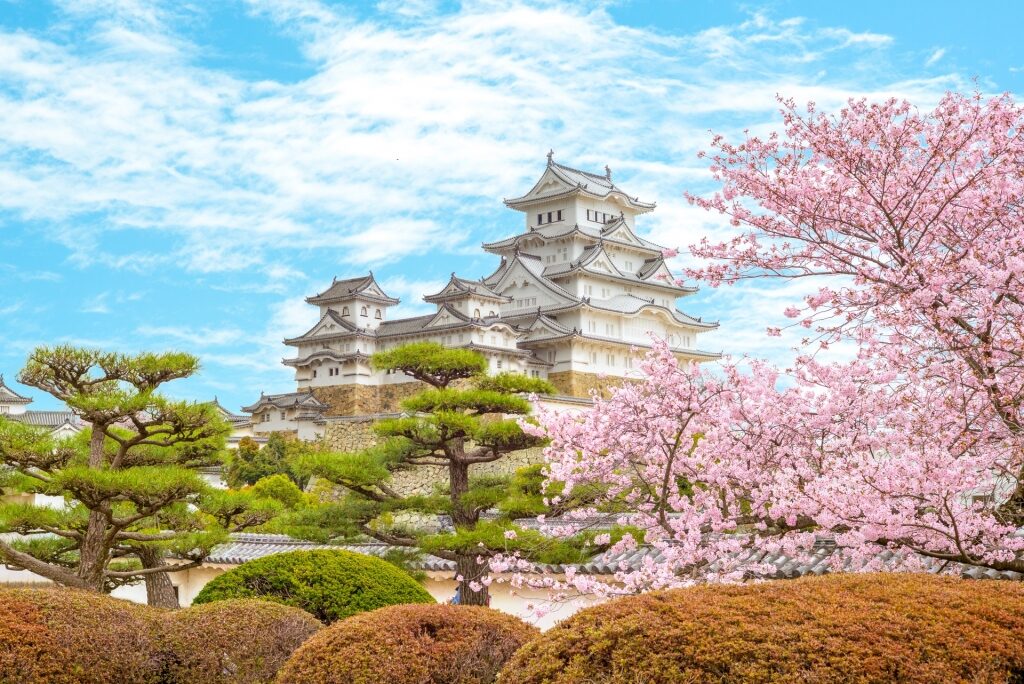
Himeji Castle, Kyoto
Japan’s most famous castle guarded one of the approaches to the former capital of Kyoto. Its feudal Edo era architecture is now recognized as a National Treasure and a UNESCO World Heritage Site.
The present castle dates to 1609 and is one of the few in Japan to survive fire, earthquakes and World War II bombing. The striking white walls and soaring roofs give it the name of White Heron Castle.
Make your way to the top floor for a good view of the dozens of buildings that make up the castle complex. You can also enjoy a good view over the town of Himeji.
In spring, the cherry blossoms in the extensive grounds make for a spectacular sight.
Read: Two Days in Kyoto
Imperial Palace, Tokyo
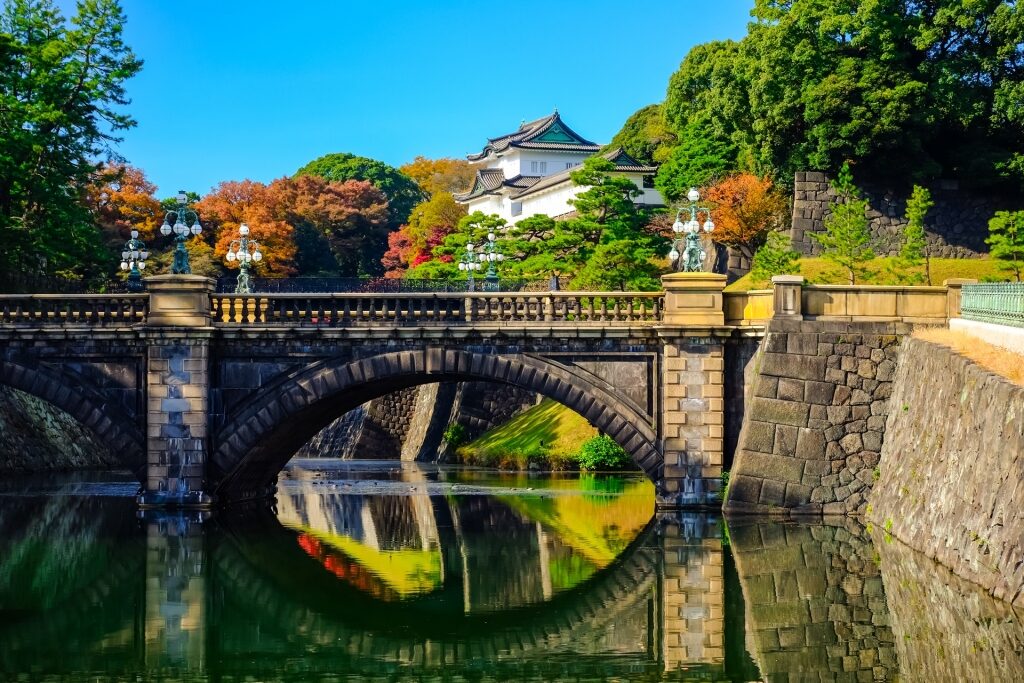
Imperial Palace, Tokyo
This has been the home of the Japanese Imperial Family since Japan moved its capital from Kyoto to what was then the town of Edo in 1868. The remains of the former 15th century Edo Castle can still be seen within the East Garden, one of the most beautiful gardens in Tokyo.
Bombed during World War II, the Imperial Palace was not fully rebuilt until the 1980s. It sits within extensive grounds and gardens behind thick walls and a moat.
The grounds hold almost a quarter of Tokyo’s trees but only the East Garden is open to the public. The rest of the grounds, but not the palace itself, can be seen on regular tours.
The palace is a particularly lovely sight in sakura, or cherry blossom season. The reflection of the pale pink cherry blossoms in the waters of the moat make for a memorable photo.
Nara Park, Kyoto
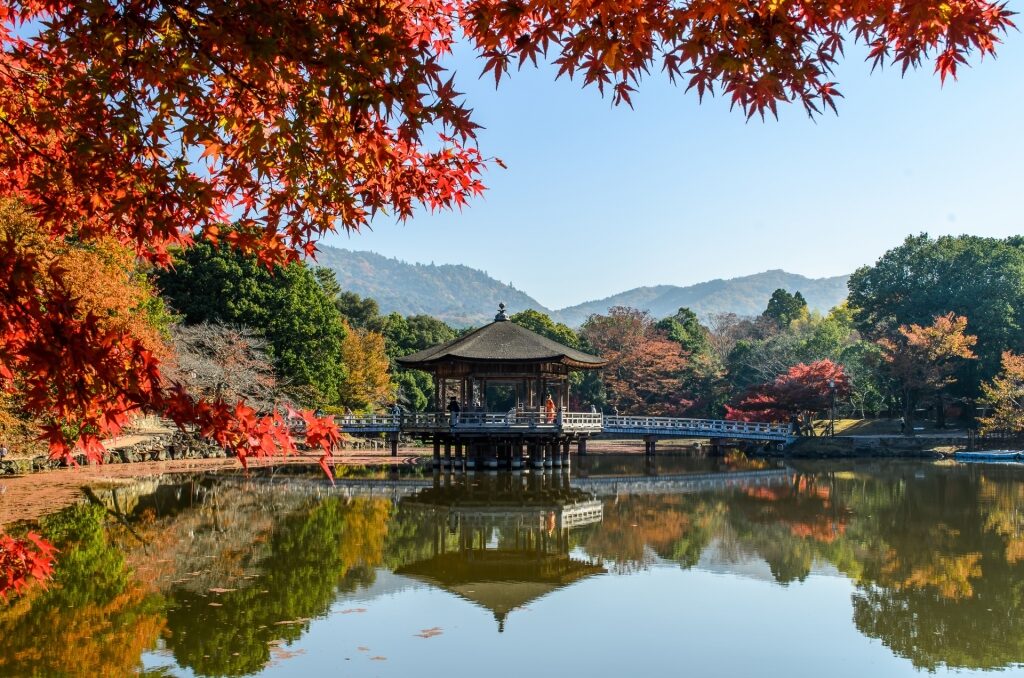
Nara Park, Kyoto
This park is one of the oldest in Japan but most visitors come for its sika deer. Some 1,400 roam freely, tame enough to eat the “shika senbei” (deer crackers) that visitors are encouraged to buy.
The deer have learned to bow so visitors feed them treats. Once you have run out of food, wave to them and they will go and look for another benefactor.
The lovely park covers a vast area filled with trees and has several historic buildings. Todaiji Temple was once the world’s largest wooden building and holds the world’s largest bronze statue of Buddha.
The five-storied wooden Kofukuji pagoda, the second tallest in Japan, was originally built in 730 and restored in 1426. It is now a symbol of the city of Nara.
Fushimi Inari Taisha, Kyoto
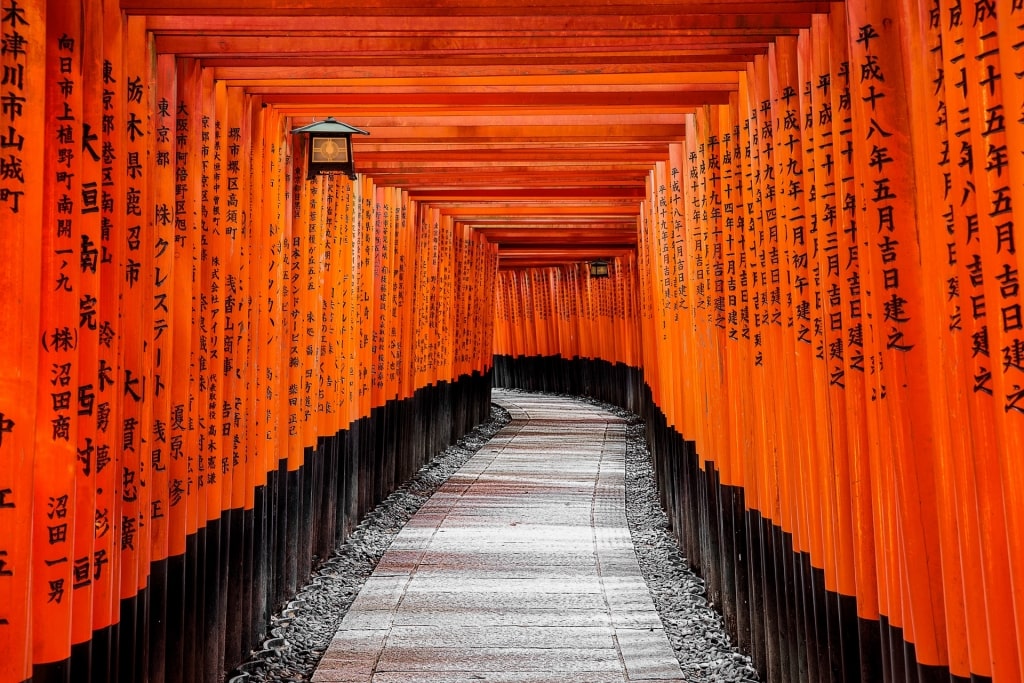
Fushimi Inari Taisha, Kyoto
The path of orange-red torii gates leading up this Shinto shrine is immediately recognizable. They mark the path up to the shrine and on to the peak of sacred Mount Inari.
While pilgrims climb to the summit, many visitors are happy with the views over Kyoto from about halfway up. Several cafés and restaurants make a great place to rest.
As well as the 10,000 torii, you will also see many statues of a fox, considered the sacred message of Inari, the Shinto god of rice. They are often white, a color symbolizing that this sacred fox is invisible to the naked eye.
You can buy a fox in the form of rice crackers, amulets and many other good luck charms. A fox face mask, handmade from paper, is very popular with Japanese visitors.
Hiroshima Peace Park, Hiroshima
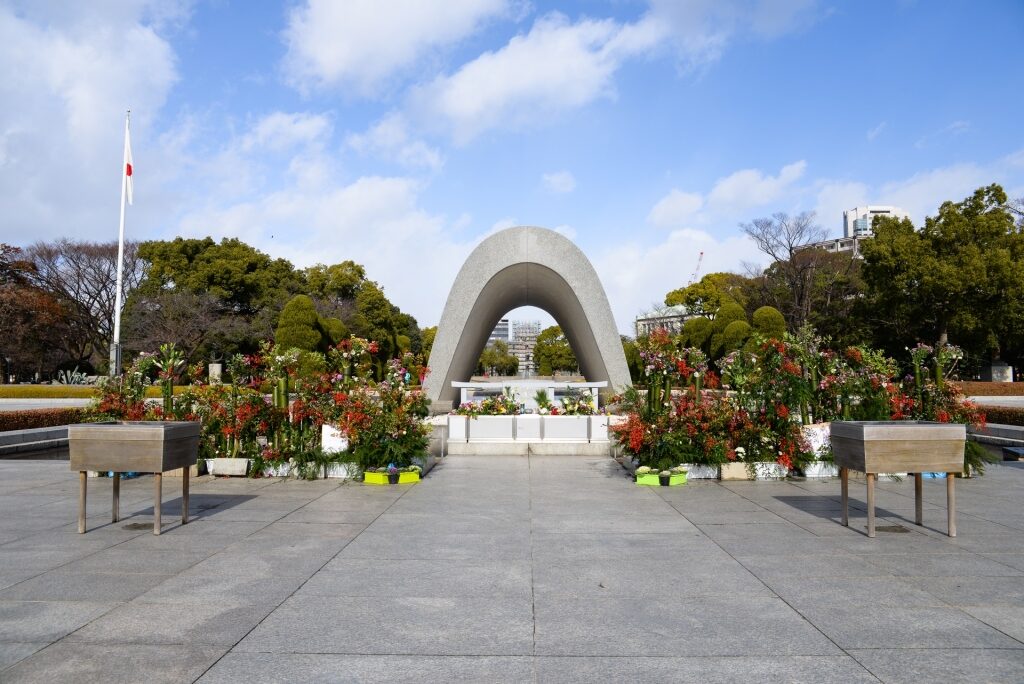
Hiroshima Peace Park, Hiroshima
Hiroshima’s most visited attraction is dominated by the A-Bomb Dome, or Hiroshima Peace Memorial. It’s a stark memorial to the atomic bombing of the city in World War II.
The dome, once at the commercial heart of Hiroshima, was one of the few buildings to survive. It’s now a Unesco World Heritage Site, a symbol of peace and remembrance.
At the center of the beautiful park itself is a cenotaph listing all the victims. Even more moving is the Children’s Peace Monument, surrounded by paper origami cranes sent from all over the world.
The Memorial Museum gives the history of the city before, during and since the bombing. Any dark memories are dispelled by a moving sense of the city’s lasting mission for peace.
Read: Top Things to Do in Hiroshima
Kinkaku-ji Temple, Kyoto
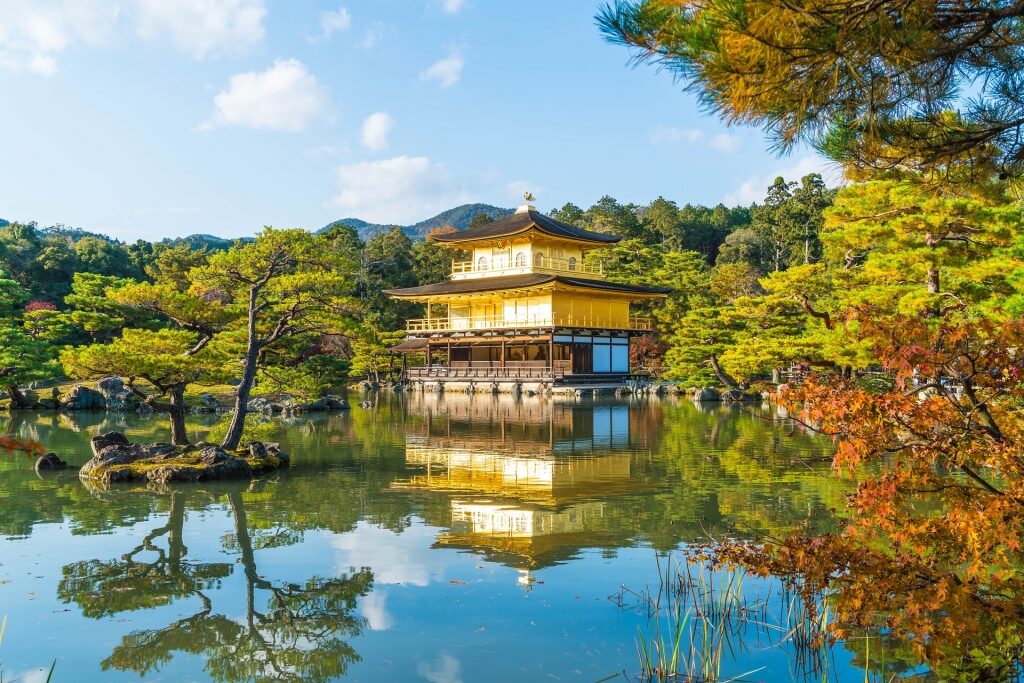
Kinkaku-ji Temple, Kyoto
Kinkaku-ji (“Golden Pavilion”) takes its name from the gold leaf covering its top two floors. A similar temple covered in silver, Ginkakuji, sits on the other side of Osaka and is a quiet alternative to Kinkakuji for those wishing to avoid crowds.
The Golden Pavilion overlooks a large pond, where its floating reflection adds to its photogenic appeal. Burnt down several times in its history, it was most recently restored in 1955.
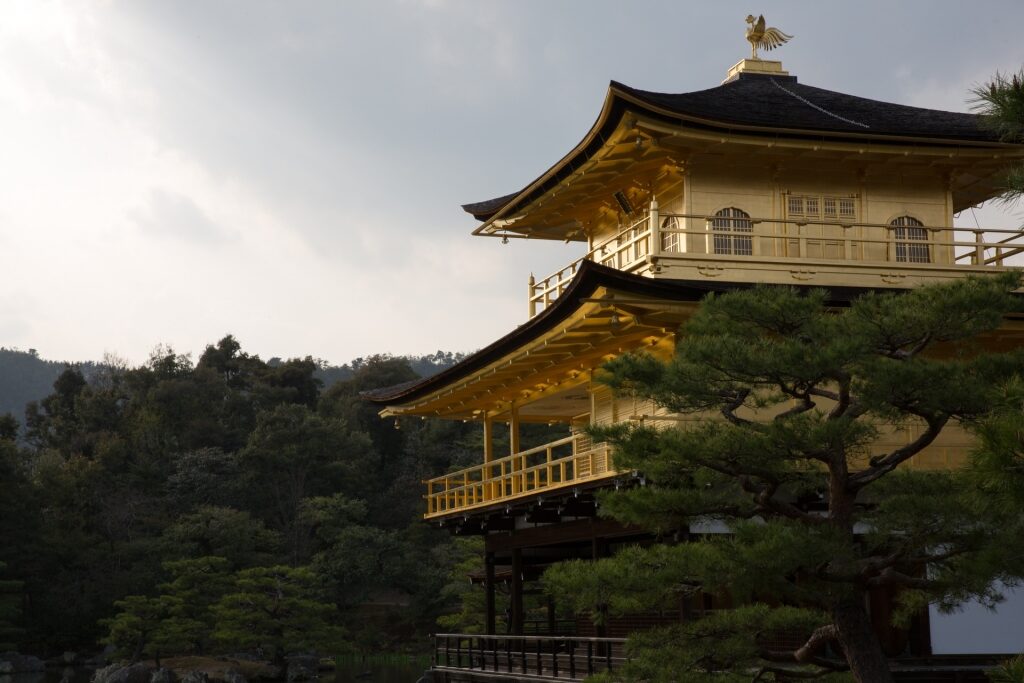
Kinkaku-ji Temple, Kyoto
Its three floors are a model of Japanese architecture from three different periods. The ground floor is of white plaster and timber, the second in the samurai style of Bukke style, and the top in Chinese style.
The gardens of this famous Japanese temple and Sekkatei Teahouse are worth a visit in themselves. The whole is now a Unesco World Heritage site.
Tokyo Tower, Tokyo
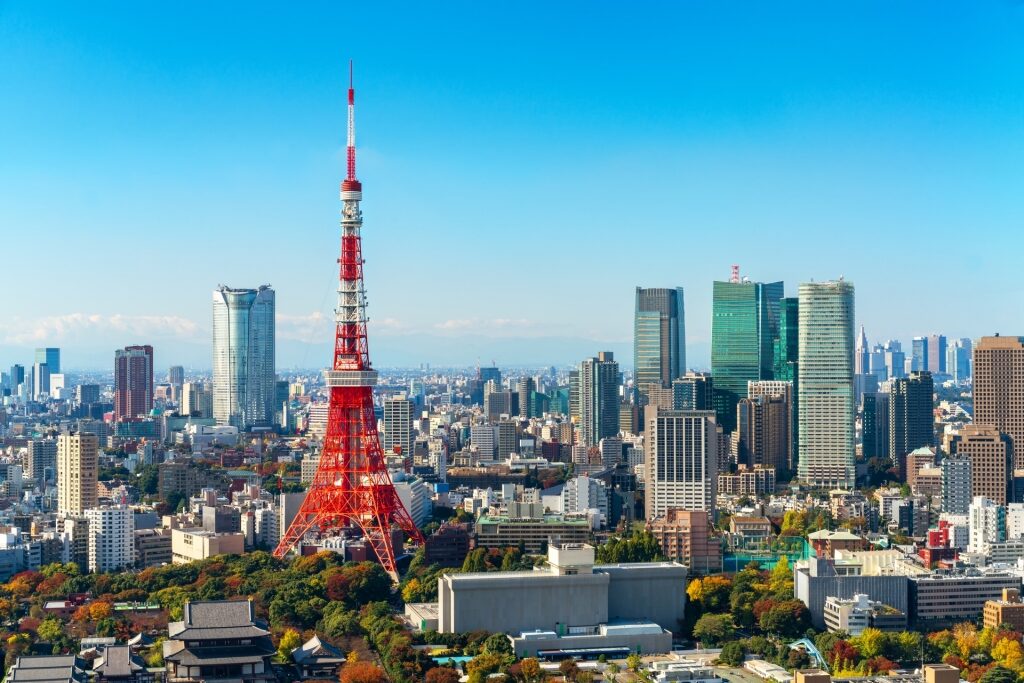
Tokyo Tower, Tokyo
Japan is home to some of the most modern cities in the world, and yet it has as much reverence for the past as it has for the future. So it’s maybe no surprise that the Tokyo Tower remains a city favorite despite more modern rivals such as the Tokyo Skytree, the tallest structure in Japan.
Tokyo Tower was opened in 1958 with a design based on the Eiffel Tower. At just over 1,000 feet, it was then the tallest structure in the country.
Built for the national broadcaster, NHK, the red and white tower has three tiers. The top is a viewing platform from where you can see as far as Mt. Fuji.
The bottom level has restaurants and souvenir shops. In the middle is an observatory with a vertigo-inducing window—try it if you dare.
Shiraito Falls, near Mt. Fuji
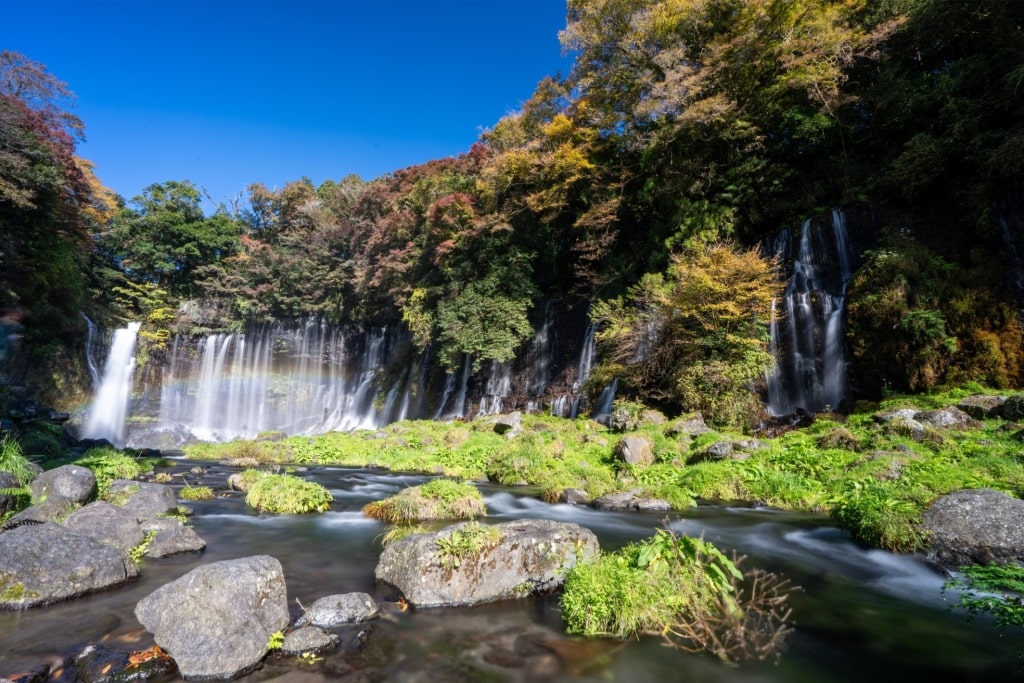
Shiraito Falls, near Mt. Fuji
The name Shiraito means “white threads,” and when you’re standing in front of them, you’ll see why, as slender water streams cascade over one another like threads of silk.
When you arrive at Shiraito Falls, take a moment to appreciate the thin white streams of water that fan out over the wide, flat rock wall, forming a beautiful, broad curtain of water.
Shiraito Falls, located in the Fuji-Hakone-Izu National Park, can be visited all year long. However, some of the best times to see these landmark falls are during the leafy spring or when the fiery foliage of autumn is on display.
Mount Hakodate, Hakodate
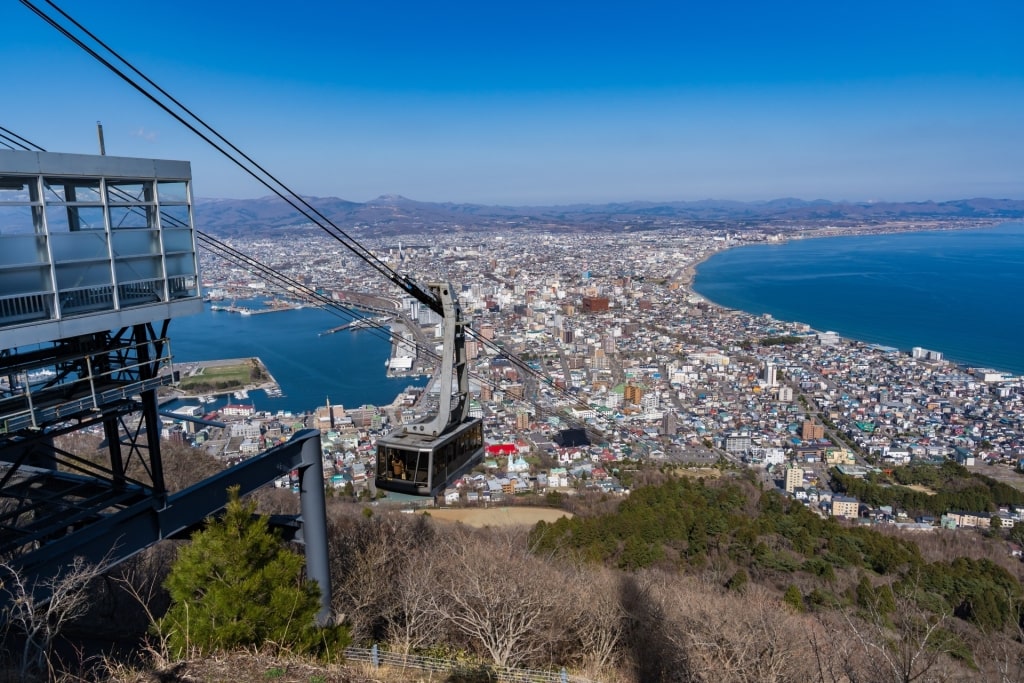
Mount Hakodate, Hakodate
As you stand at the summit of Mount Hakodate, you will be treated to a fantastic panorama over the hourglass-shaped city below, with Hakodate Bay on one side and the Tsugaru Strait on the other.
From the observation deck, you can also spot historic attractions in the distance, such as Goryokaku Fort and the old port district, adding to this mountain’s allure as one of the most famous landmarks in Japan.
You can hike up different trails to the summit, or take the scenic Hakodate Ropeway to take in these spectacular views.
Hirosaki Castle, Aomori
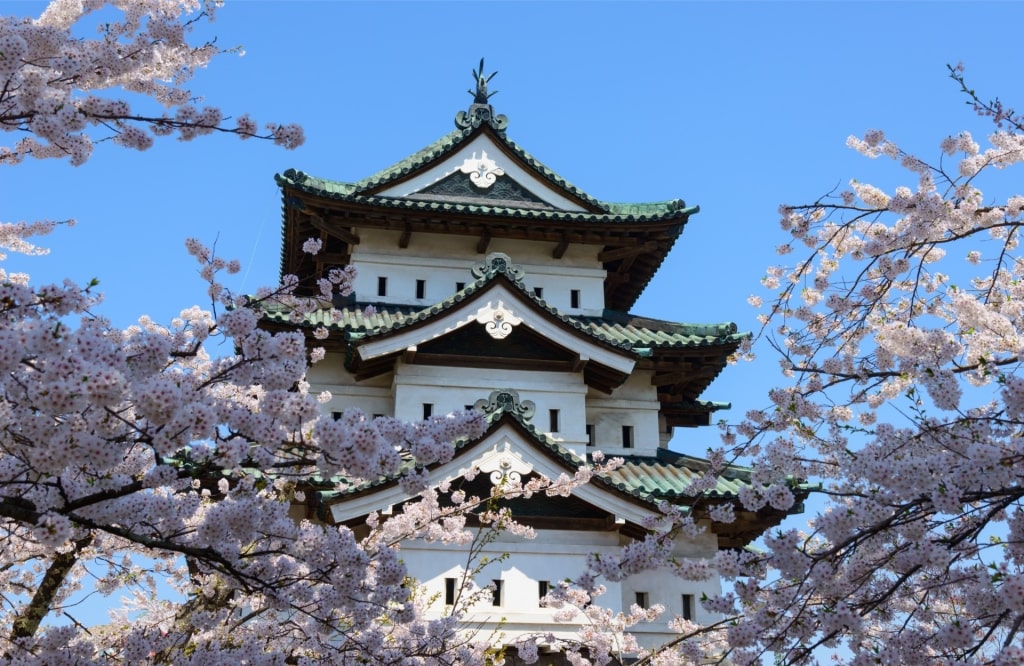
Hirosaki Castle, Aomori
One of Japan’s most beautiful places, Hirosaki Castle was built in 1611 for the Tsugaru clan during the Edo period. The castle’s original tower, or donjon, was destroyed by lightning and has been carefully maintained since its reconstruction in 1810.
The castle is notable for its relationship to the changing seasons. In the autumn, the vibrant crimson and gold foliage of the trees and leaves in and around the castle grounds add to the landmark’s unique beauty.
In the winter, the castle park transforms into a snow-covered wonderland during the Snow Lantern Festival, when visitors can stroll through lantern-lit paths.
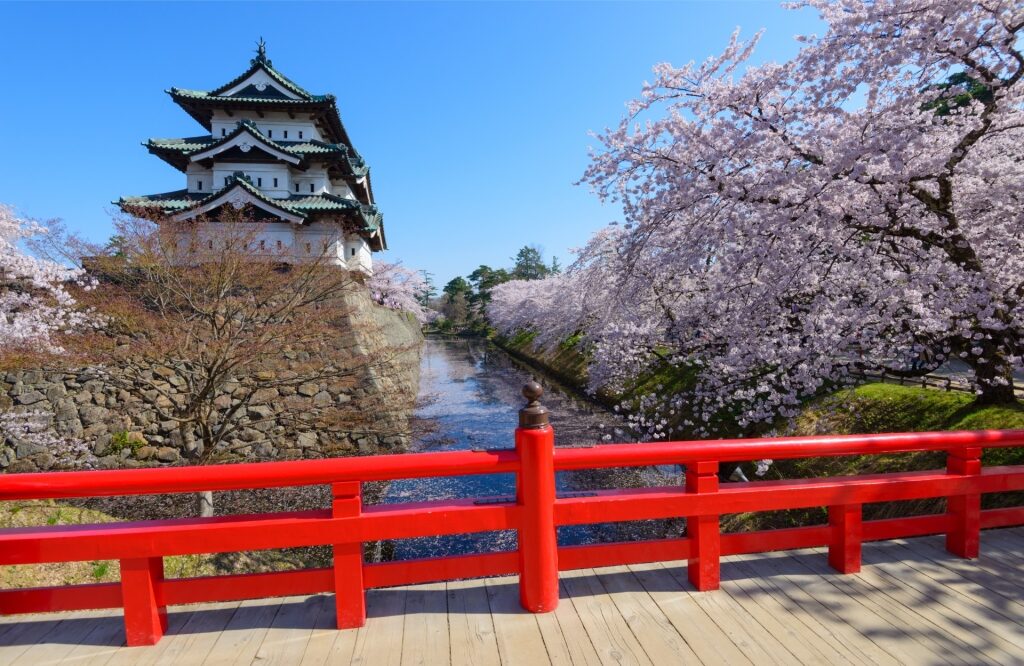
Hirosaki Castle, Aomori
During spring in Japan, it’s a sight to behold, when more than 2,500 pink-hued cherry blossom trees come into bloom.
Hirosaki Castle, with its scenic bridges, moat, and pretty gardens and grounds, is a place where history and nature come together, no matter the season.
Chureito Pagoda, Fuji Five Lakes Region
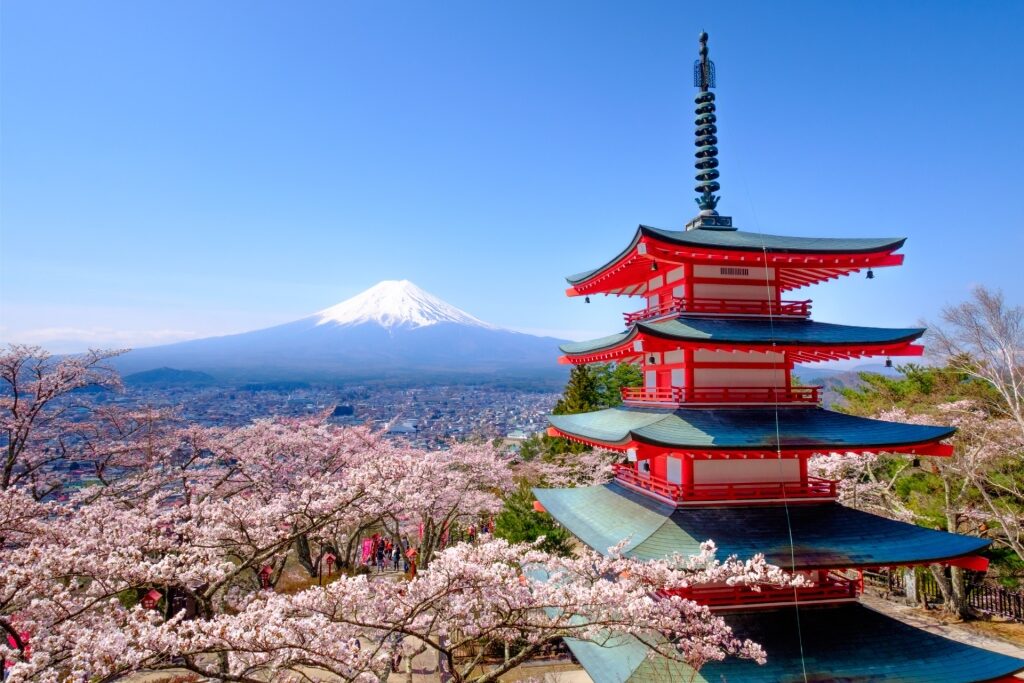
Chureito Pagoda, Fuji Five Lakes Region
Chureito Pagoda is one of the most famous pagodas in all of Japan. The view from this five-story structure, located at the top of Mount Arakura, artfully frames Mount Fuji in the background, with the red pagoda adding an elegant touch to the entire scene.
Getting to the Chureito Pagoda, however, does require a bit of effort. You will have to trek up and down nearly 400 steps to reach the top of the hill.
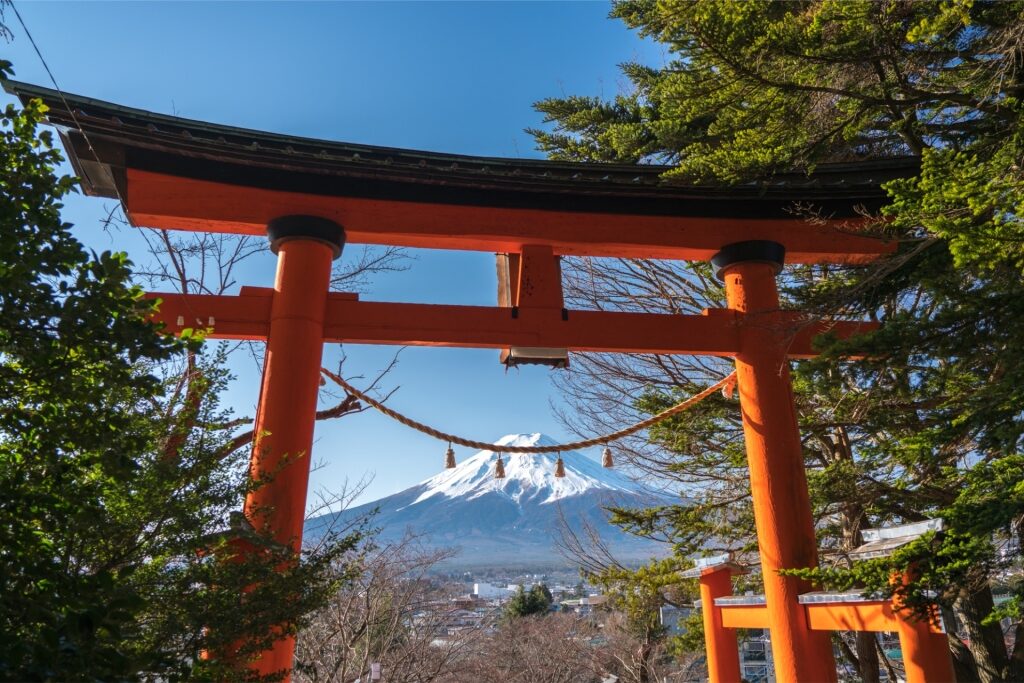
Arakura Sengen Shrine, Fuji Five Lakes Region
The relatively newer pagoda, built in 1963 as a peace memorial, is part of the much older Arakura Sengen Shrine, which dates back to 705 A.D.
Like many famous landmarks in Japan, the character of Chureito Pagoda changes with the seasons. The most apparent changes come in the springtime with its cherry blossoms, although the red autumn leaves are gorgeous, too.
Gyokusendo Cave, Okinawa
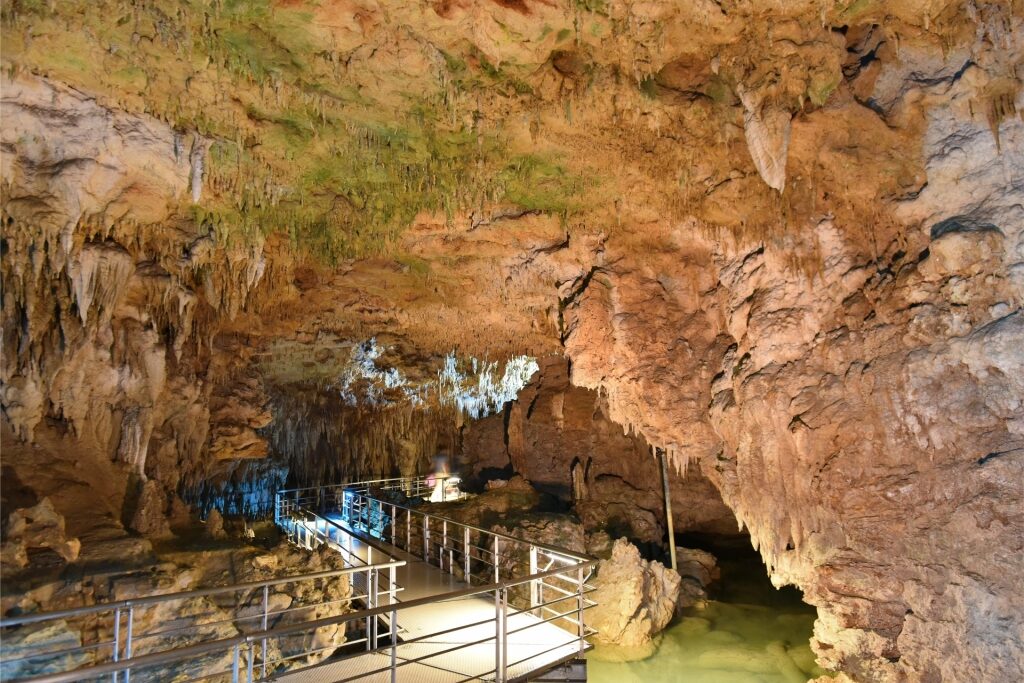
Gyokusendo Cave, Okinawa
Gyokusendo Cave is the second-longest cave in Japan. As you stroll across the cave’s raised boardwalk, you’ll explore a subterranean world with thousands of stalactites and stalagmites as your main companions.
The air inside is cool and misty, offering a lovely reprieve from the Okinawan heat outside. The walkway comes with just enough artificial lighting to illuminate your way.
This ancient cave system is more than five kilometers, or a little over three miles in length, although only about 850 meters are currently open to the public.
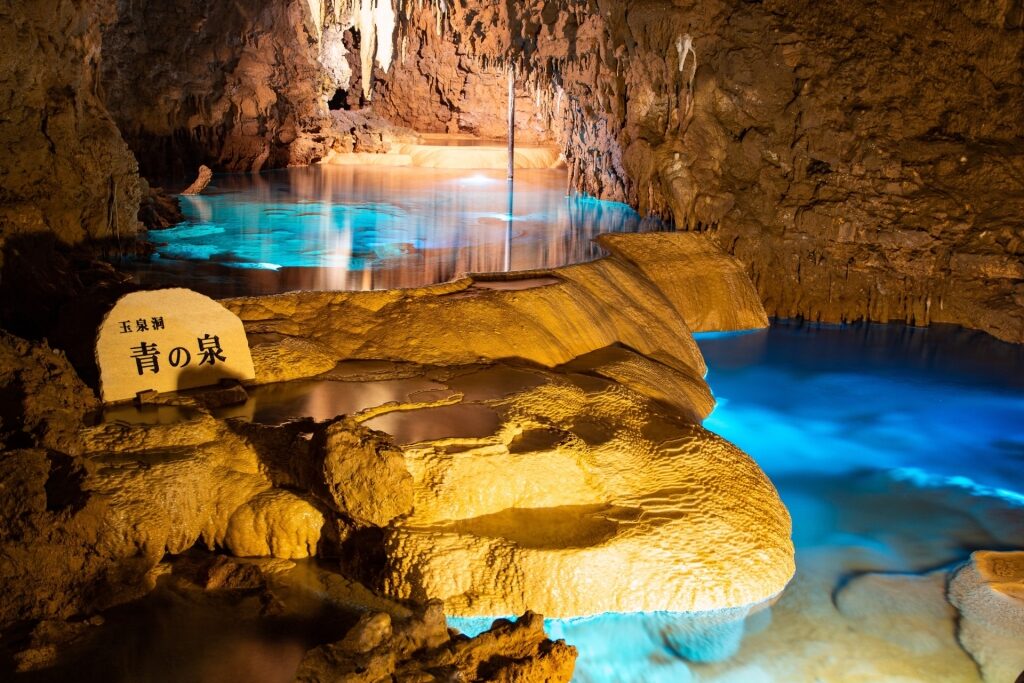
Blue Fountain in Gyokusendo Cave, Okinawa
The cave, made of coral limestone, is home to various features with poetic names, including the “Blue Fountain” cave pond and the “Golden Cup” limestone formation.
Just outside the cave entrance, you can explore the Okinawa World theme park, where you can experience the ancient arts and crafts of Okinawa, traditional Ryukyu music, and even see a pit viper snake show.
Meiji Shrine, Tokyo
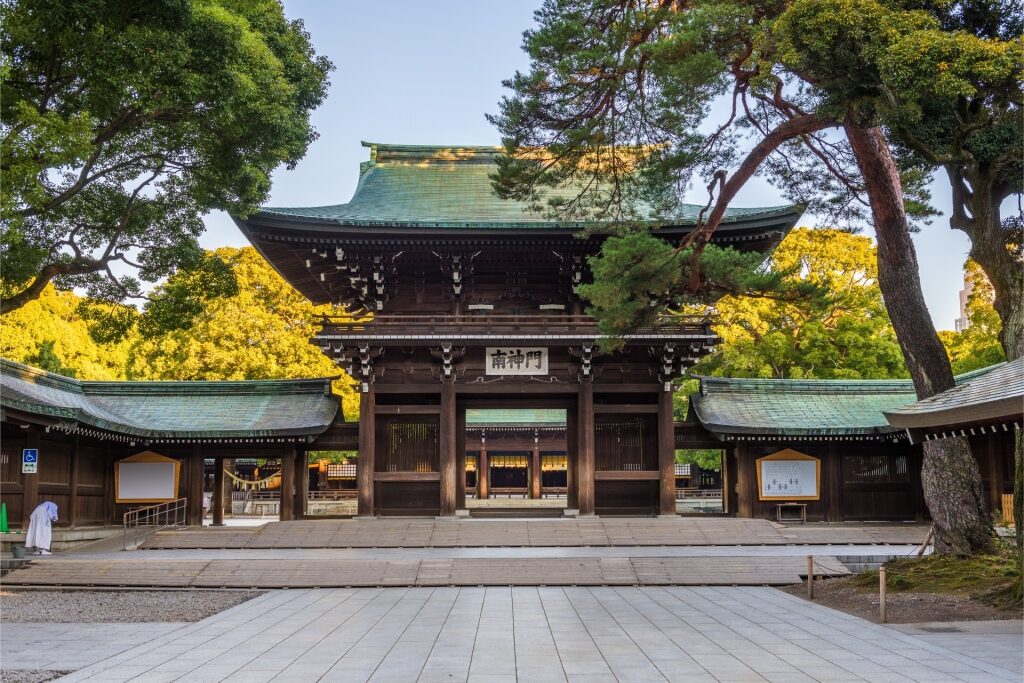
Meiji Shrine, Tokyo
Tokyo’s Meiji Shrine, to put it simply, is sublime. As you walk through its large wooden torii gates and down a gravel path shaded by towering cedar and cypress trees, the clamor of the surrounding megalopolis quickly disappears.
Meiji Shrine is dedicated to the memory of Emperor Meiji and his wife, Empress Shoken, who helped guide Japan through the Meiji Restoration, which led to the modernization of Japan.
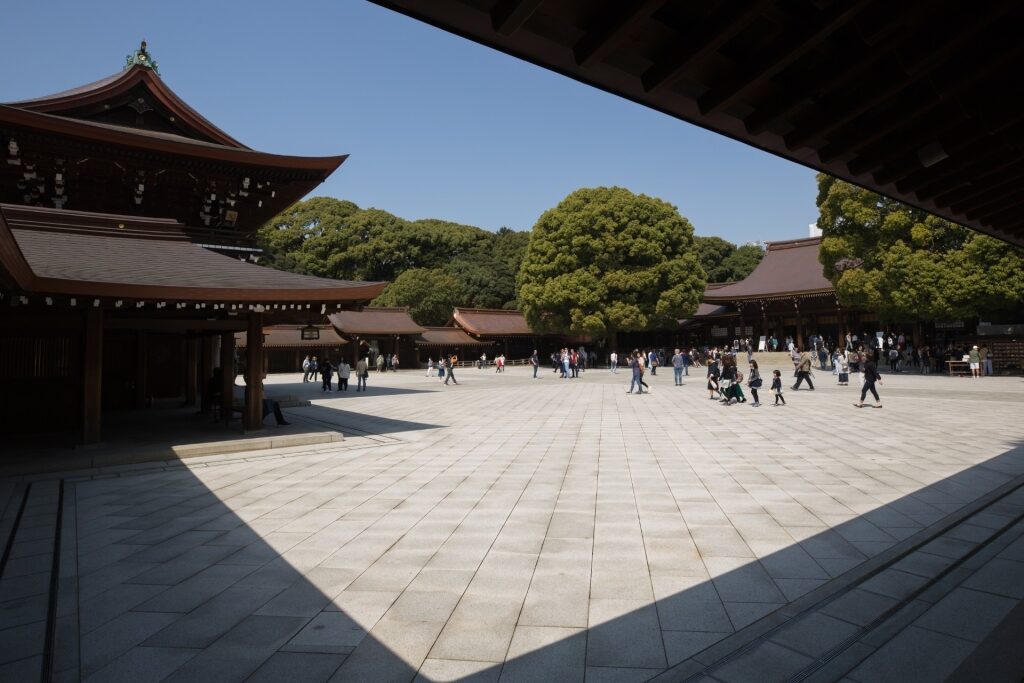
Meiji Shrine, Tokyo
The original shrine was destroyed during World War II and later rebuilt.
The shrine is a peaceful spot where you can enjoy nature, Shinto religious traditions, Shinto weddings, colorful spring and New Year’s festivals, and offer wishes on wooden plaques for good fortune related to luck, love, and business.
Read: Three Days in Tokyo
Sandankyo Gorge, near Hiroshima
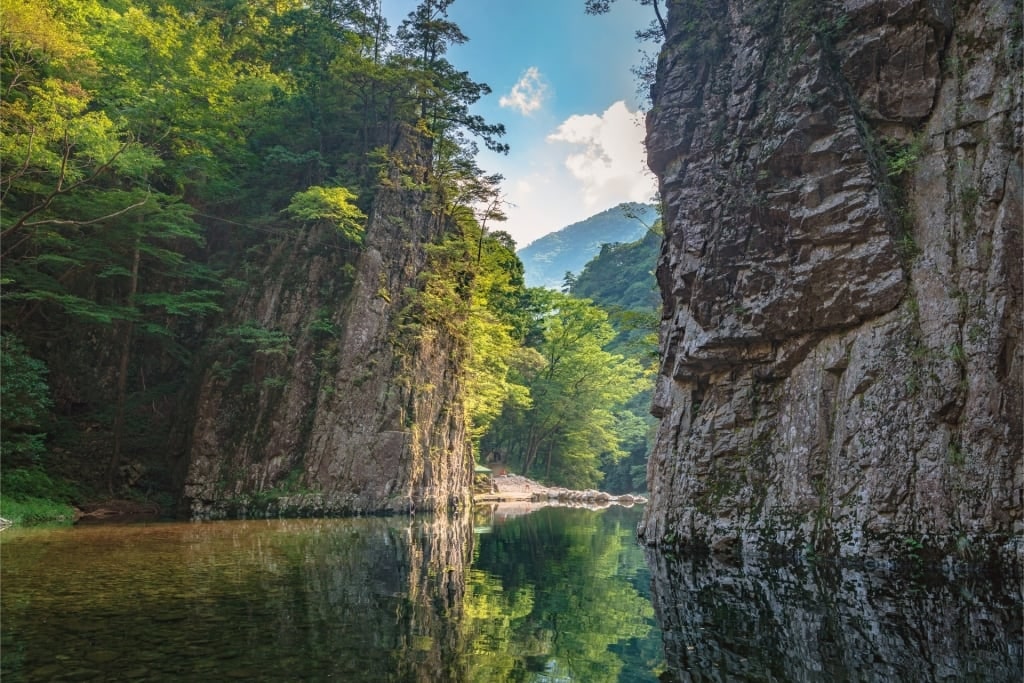
Sandankyo Gorge, near Hiroshima
About an hour’s drive from Hiroshima, you’ll come across the incredibly scenic Sandankyo Gorge, famed for its stunning autumn foliage.
Sandankyo Gorge is a deep ravine nestled in the mountains of Hiroshima. It’s a haven for hikers and nature lovers who want to escape into emerald forests marked by cascading waterfalls.
Stretching about 13 kilometers—or almost eight miles—along the Shiwagi River, this picturesque gorge offers multiple hiking trails that wind past crystal-clear pools and steep, mossy rock formations.
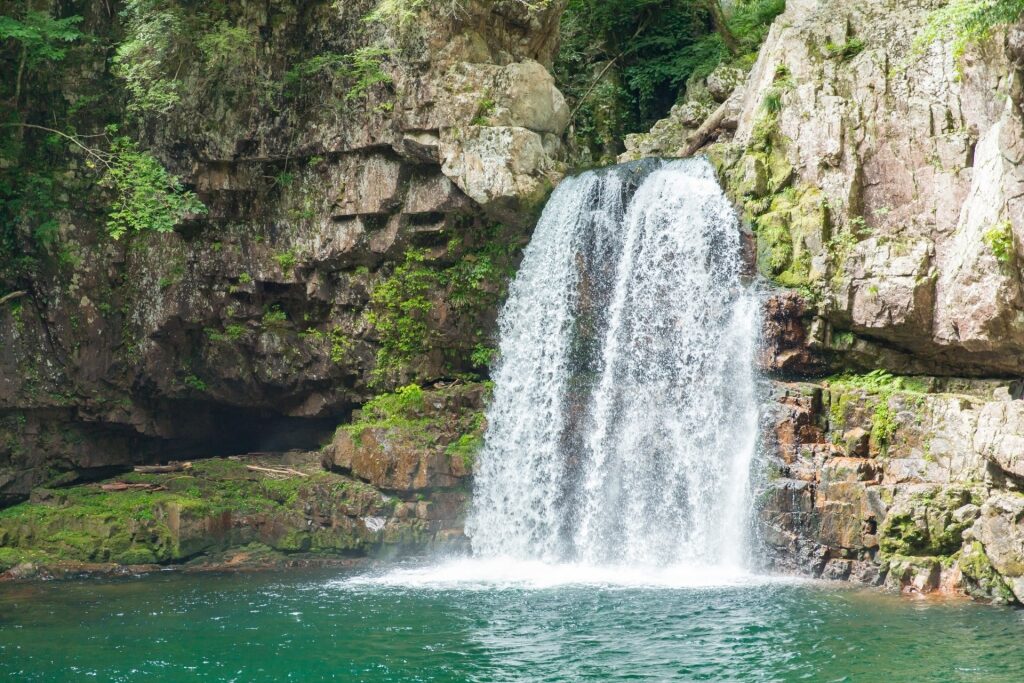
Nidan Falls, near Hiroshima
There are several scenic spots, such as Nidan Falls, that you won’t want to miss. At Kurobuchi Pool, you can opt for a small boat ride to take you through the narrowest points of the gorge.
Once you hit the water, you’ll quickly understand why Sandankyo Gorge has been named a “National Special Place of Scenic Beauty” and numbers among the most famous landmarks in Japan.
Goryokaku Fort & Tower, Hakodate
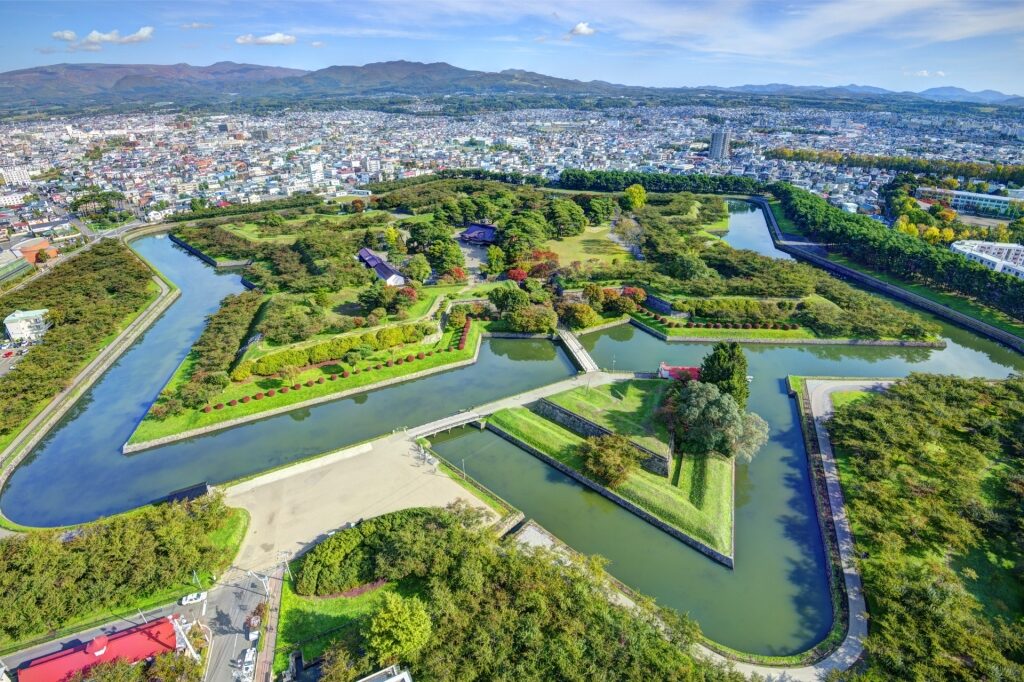
Goryokaku Fort & Tower, Hakodate
Goryokaku Fort is a star-shaped fortress unlike anything else you’ll find in Japan, as it was modeled on European defensive designs. When you arrive, you will step through the history books into the samurai era.
Built in the 1860s during the Tokugawa shogunate to protect Hakodate against possible invasion from foreign powers, Goryokaku was the site of the last battle of the Japanese Civil War.
These days, the fort makes for a fun visit, with cherry trees that bloom every spring, a massive moat, and abundant greenery.
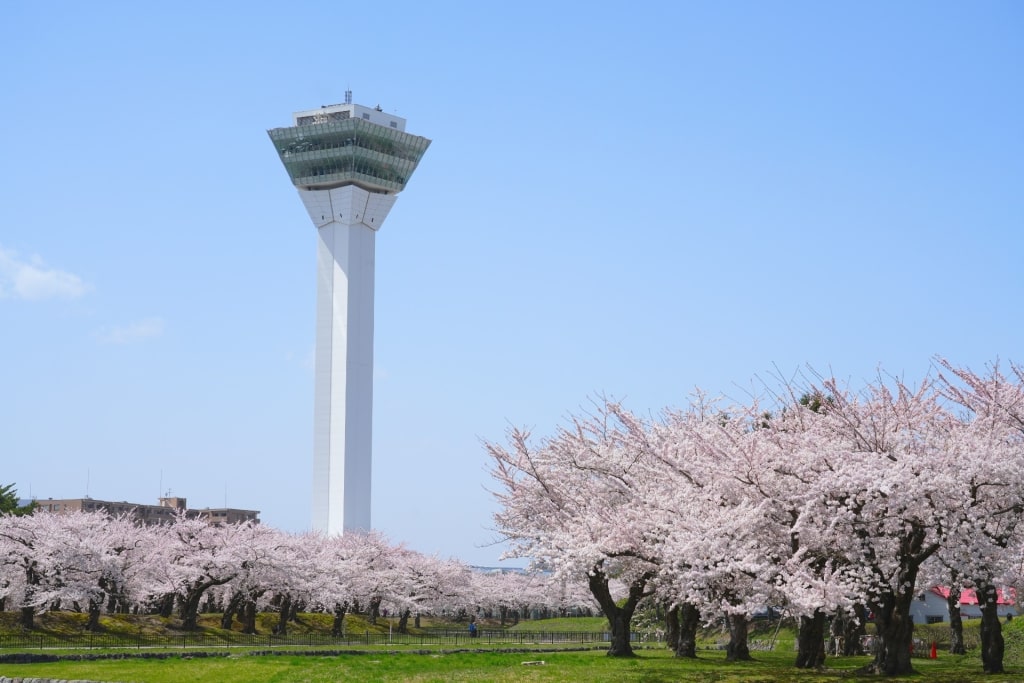
Goryokaku Tower
One of the highlights is climbing Goryokaku Tower to the observation deck. Soak up the incredible view of the fort’s star-shaped symmetry, which you can easily miss from the ground.
Inside the tower, you’ll also find exhibits that explain the history of the fort, as well as the battle that took place on its grounds, and the area’s transformation into the Hakodate you see today.
Mount Rokko, Osaka
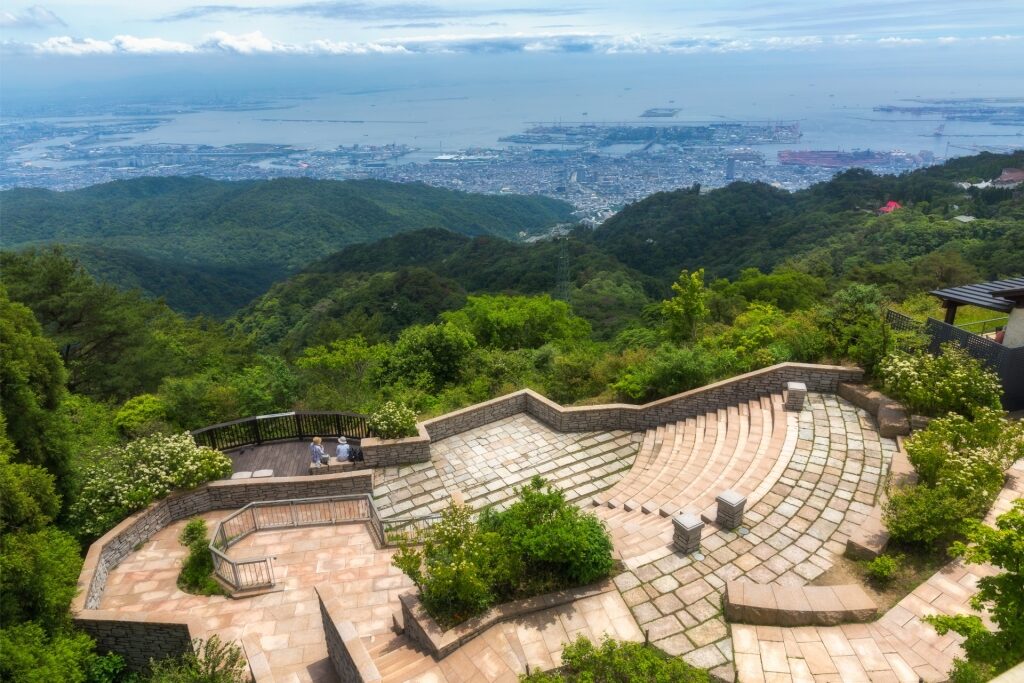
Mount Rokko, Osaka
If you want a break from Osaka’s urban commotion, head to Mount Rokko. This stunning highland area is easily accessible by train and cable car from Kyoto and Osaka.
Breathe in the mountain air, hike forested trails, and enjoy some of Kansai’s finest panoramas. At the summit, you’ll be rewarded with a bird’s-eye view of Osaka Bay, Kobe’s skyscrapers, and Awaji Island on a clear day.
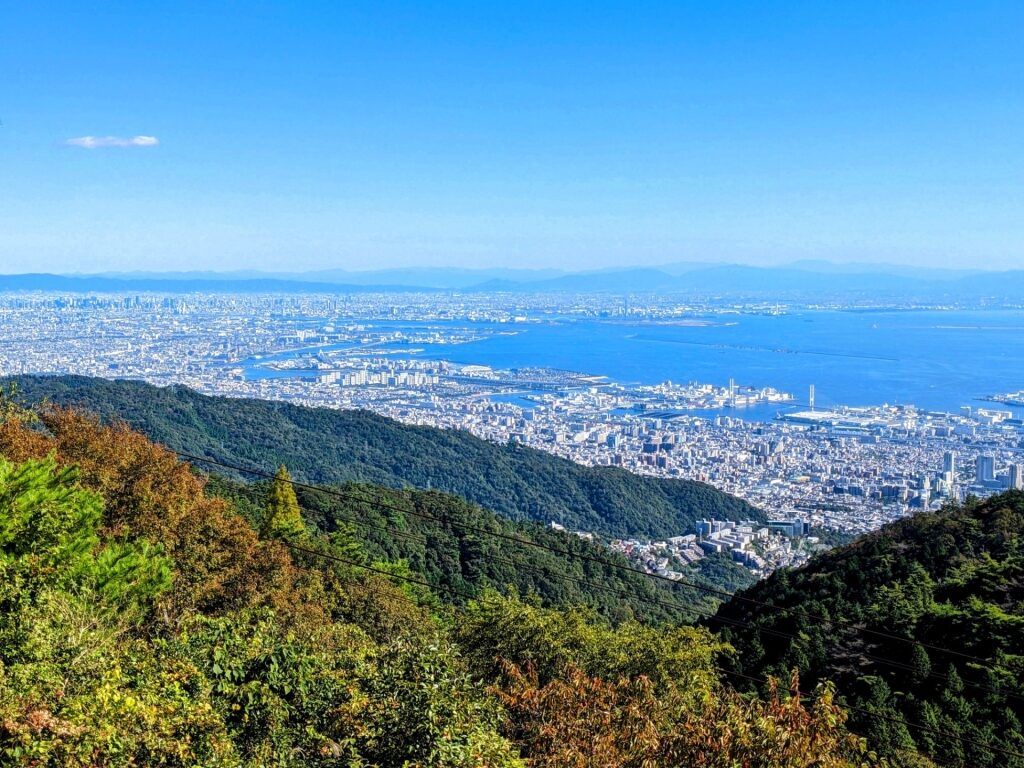
Rokko Garden Terrace, Osaka
You can also visit Rokko Garden Terrace for its cafés and observation platforms, or stroll through Rokko Alpine Botanical Garden to see its collection of alpine plants from around the world.
During the muggy summer in Japan, Mount Rokko offers a comfortable respite from the city heat, though with its seasonal landscapes, it’s worth visiting at any time of the year.
Shirakami-Sanchi, Aomori
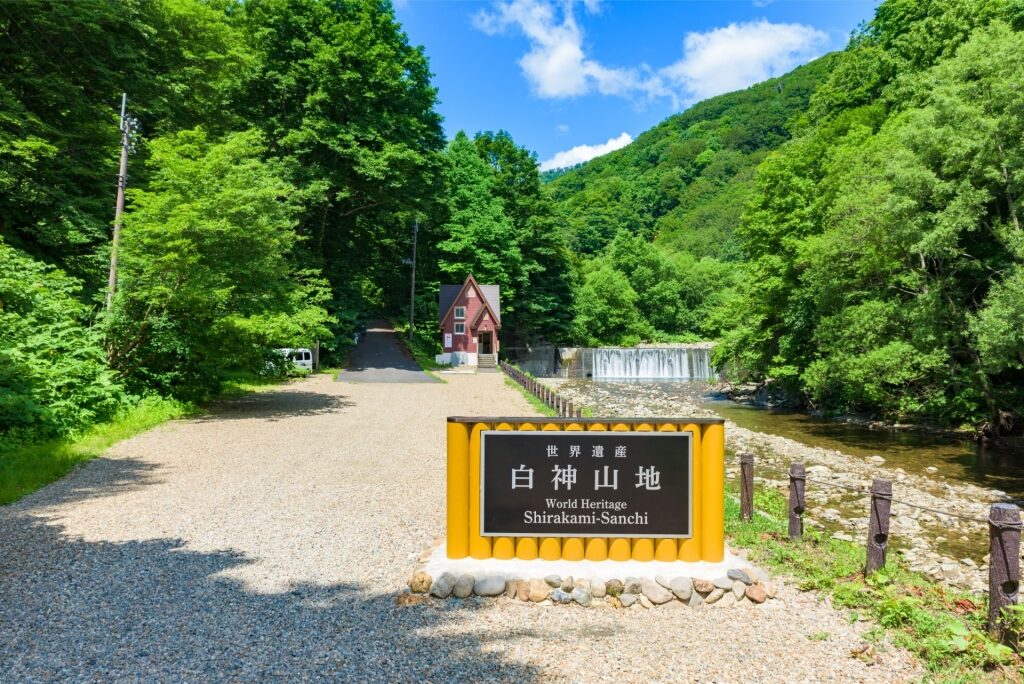
Shirakami-Sanchi, Aomori
If you want to swap the modern world for something more primeval, Shirakami-Sanchi is an excellent choice. This mountainous region on the border of Aomori and Akita Prefectures is home to one of the largest remaining virgin beech forests in East Asia.
The lush green canopy is filled with towering beech trees that overlook interlacing forest trails.
The trees and their deep roots form an ecosystem so ideal that the region has been named a UNESCO World Heritage Site. This pristine wilderness is filled with bird song, calls of macaque monkeys, and the other creatures that reside here.
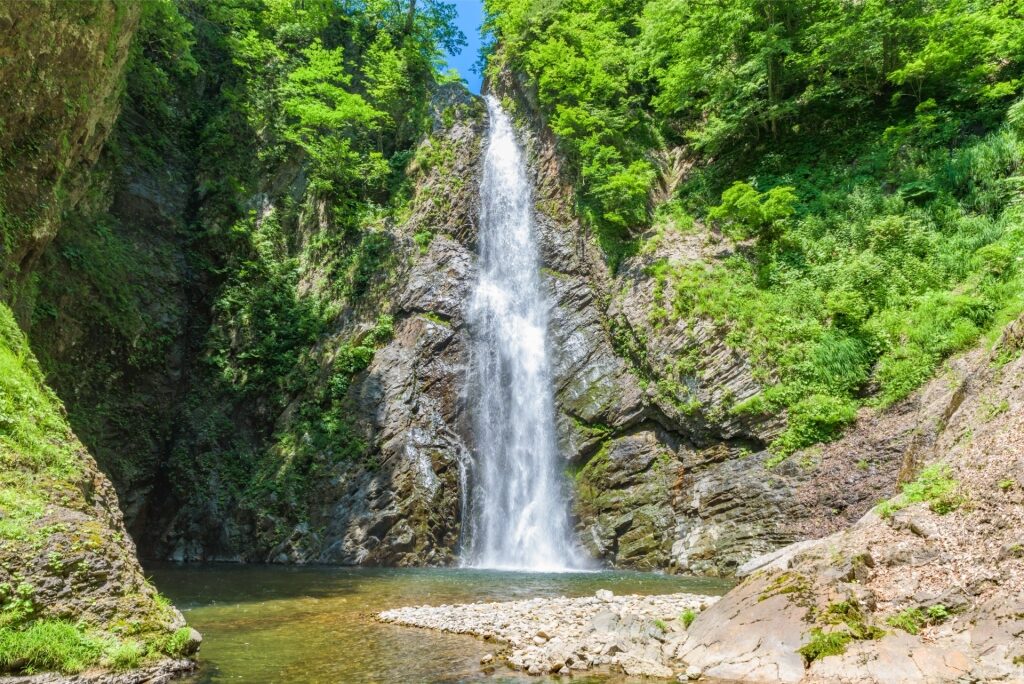
Anmon Falls in Shirakami-Sanchi, Aomori
This trekker’s paradise offers trails for every level, from easy nature walks to multi-day routes for more adventurous hikers. One major highlight is Anmon Falls, a trio of impressive tiered waterfalls located deep within the forest.
Kochi Castle, Kochi
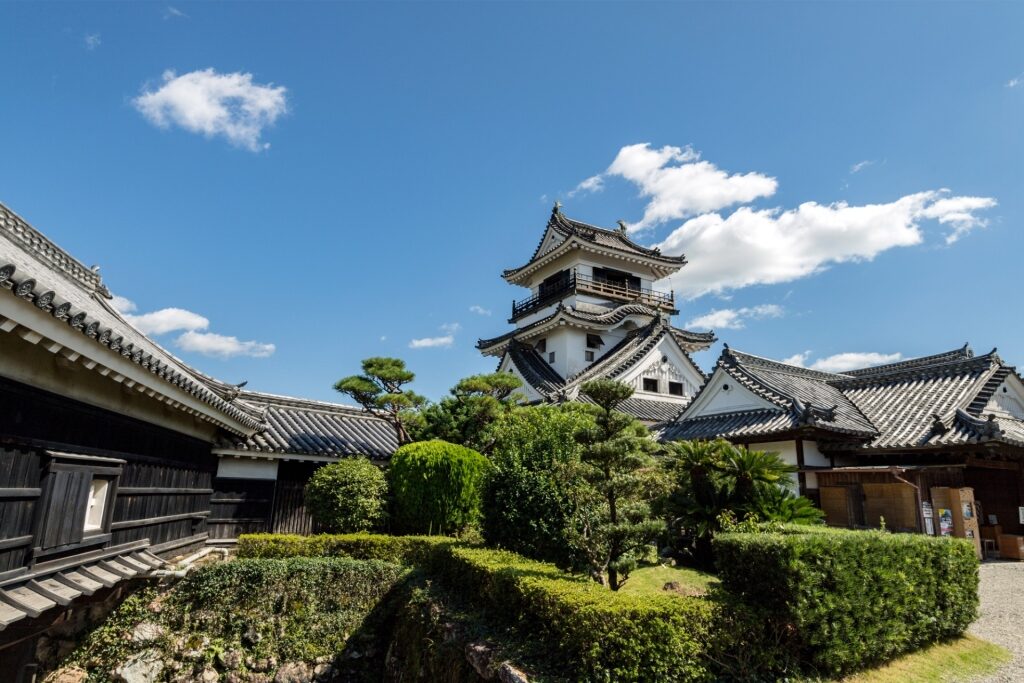
Kochi Castle, Kochi
Don’t let this castle’s beauty fool you; Kochi Castle is one formidable fortification that has survived a variety of disasters to remain intact into the modern era.
Completed in the early 1600s by Lord Yamauchi Kazutoyo, Kochi Castle served as a seat of authority and protection for the Tosa Domain. Climb the steep stone steps that lead to the main keep for sweeping views of Kochi.
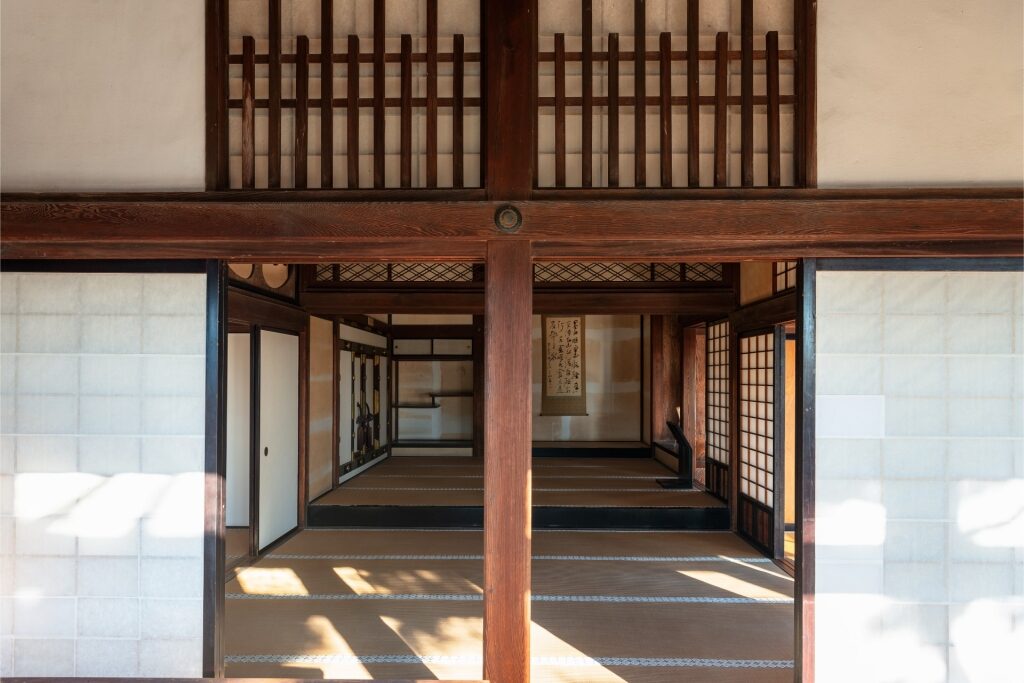
Kochi Castle, Kochi
Unlike other castles in Japan, Kochi Castle retains its original wooden interiors. It’s also the only castle in Japan with an intact main keep and palace.
The Kochi Castle Museum of History features displays that bring the legend of the Yamauchi clan to life and offers deeper insights into the castle and the region’s history.
Sakurajima, Kagoshima
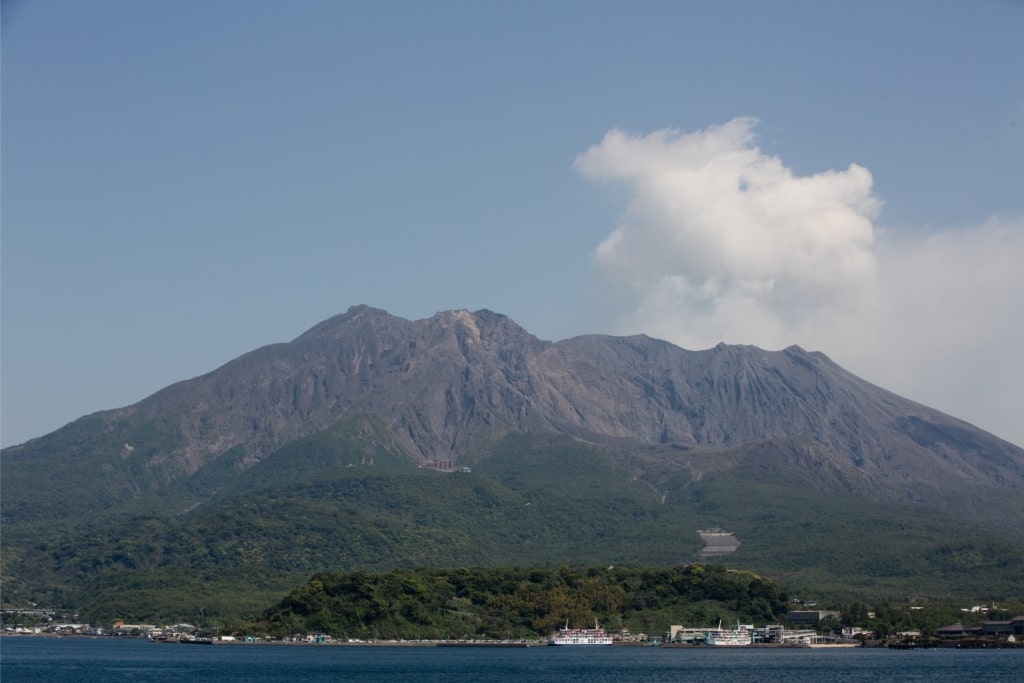
Sakurajima, Kagoshima
There’s something truly awe-inspiring about standing on an island that’s also an active volcano, and that’s precisely the experience you’ll get at Sakurajima.
Once a separate island, this forceful stratovolcano was connected to the Osumi Peninsula after a huge eruption in 1914, which sent flowing lava into the sea. Smoke still pours out of the crater, reminding you that this fire mountain is still very much alive.
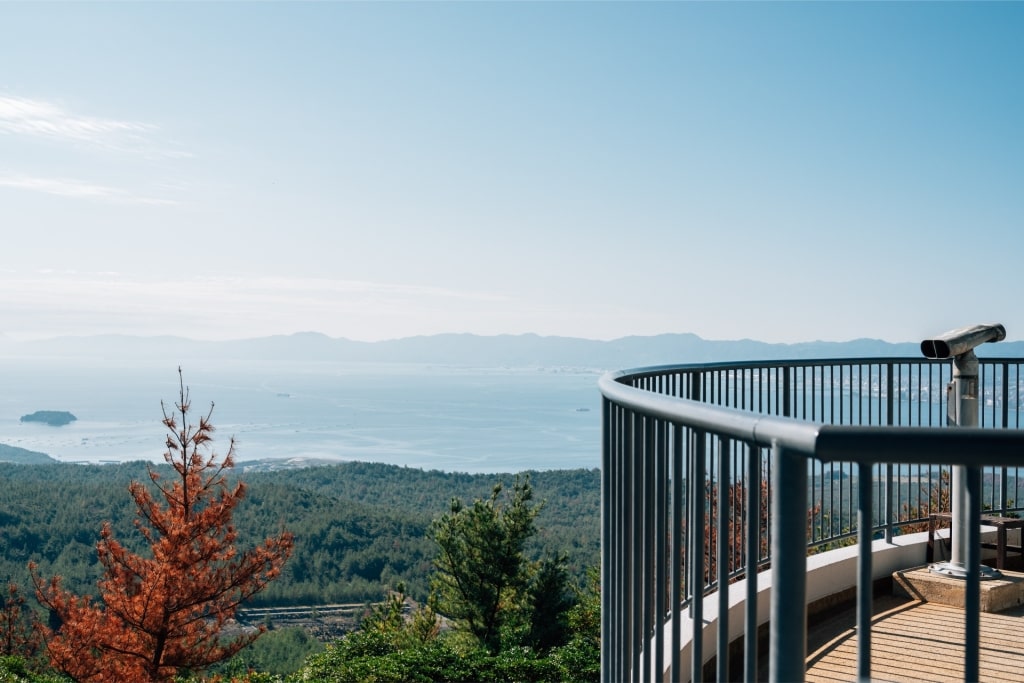
Yunohira Observatory, Kagoshima
You can access the island easily by ferry from the busy port of Kagoshima, and then take the mountain in from spots like the Yunohira Observatory, which provides up-close views of the smoking summit.
If you want to stretch your legs, wander past hardened lava fields along the Nagisa Lava Trail. Afterward, soak your feet in a natural hot spring foot bath, located close to the Sakurajima Port Ferry Terminal, while you enjoy vistas of Sakurajima and Kinko Bay.
Fukuoka Tower, Fukuoka
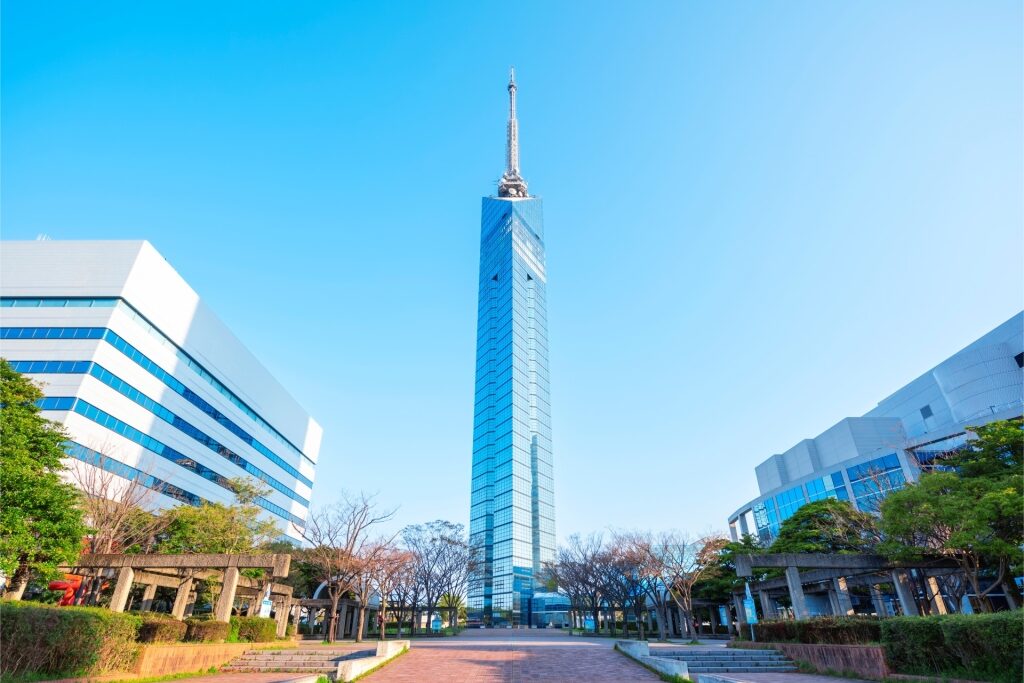
Fukuoka Tower, Fukuoka
Fukuoka Tower, situated along Fukuoka’s waterfront, is a Japanese landmark built to impress with its gleaming, triangular prism shape.
Soaring up to 234 meters, or 768 feet into the sky, this is Japan’s tallest seaside tower. It’s wrapped in mirrored glass that reflects sunlight and city lights with a mesmerizing effect.
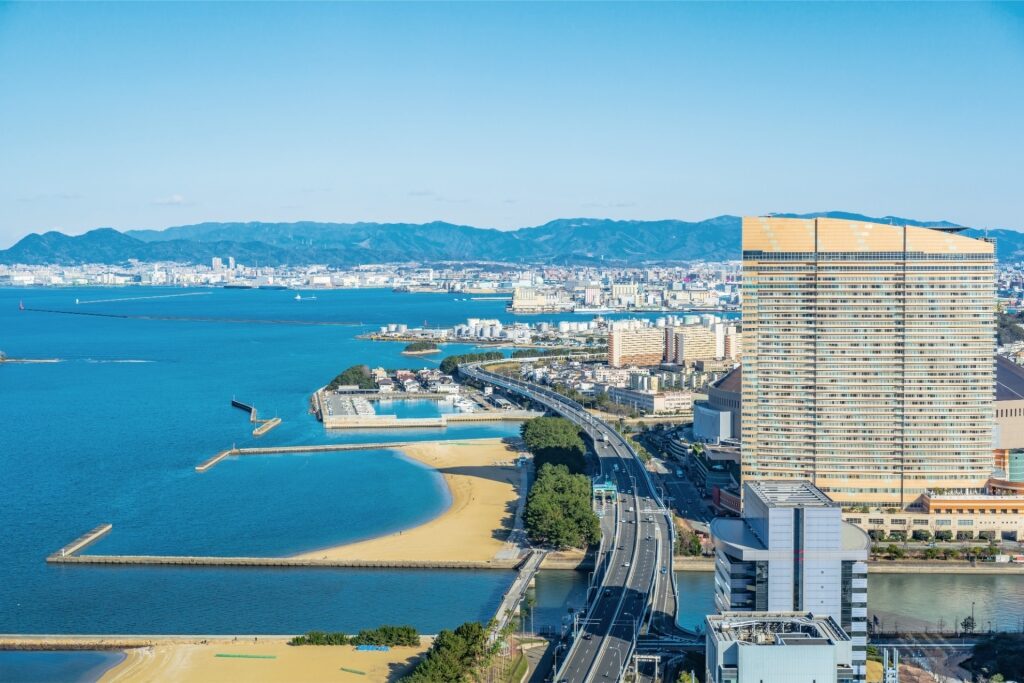
View from Fukuoka Tower, Fukuoka
The modern design of the tower fits in well with the relaxed yet forward-thinking vibe of Fukuoka. A quick elevator ride will take you up to the tower’s different observation decks, affording you 360-degree views of the city, Hakata Bay, and the nearby Sefuri Mountains.
There’s also a “Lover’s Sanctuary” at the top, complete with a spot to leave love locks. Downstairs, the Momochi Seaside area features beaches, shopping, and plenty of cafés where you can relax after admiring the views of the skyline.
FAQs
What is the most iconic natural landmark in Japan?
Mount Fuji, Shimizu
Mount Fuji is the clear answer here. It’s Japan’s highest mountain, with a perfectly symmetrical snow-capped volcanic summit that is both a UNESCO World Heritage Site and a fixture in Japanese art and culture.
What landmarks offer the most historical traditions in Japan?
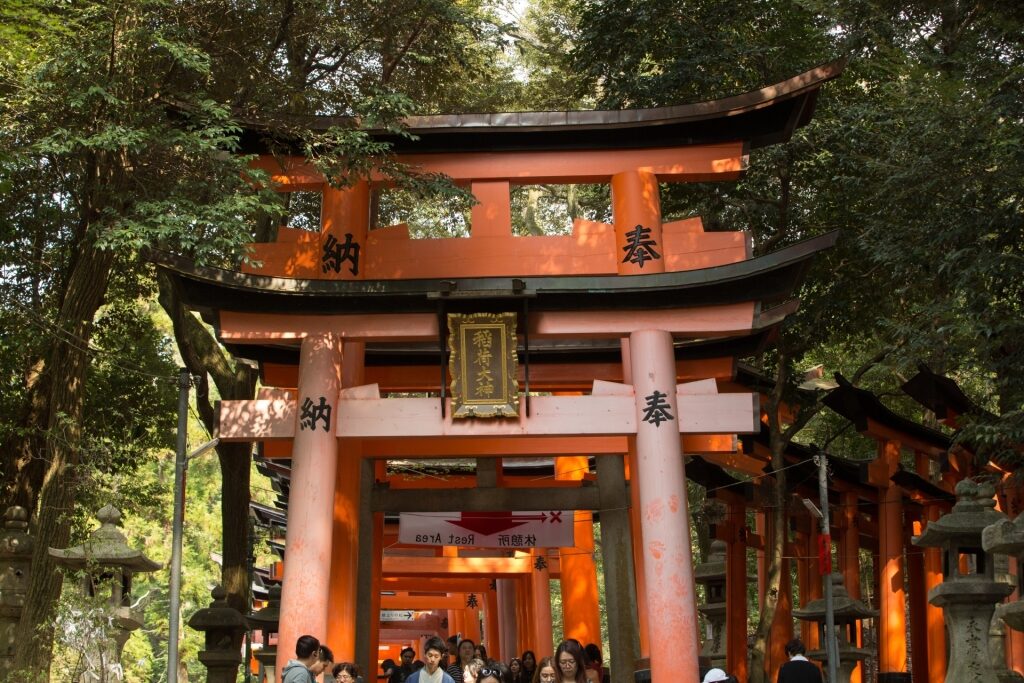
Fushimi Inari Shrine, Kyoto
Kyoto and its surroundings offer a treasure trove of historic temples and shrines, like Kiyomizu-dera Temple, the Golden Pavilion, and Fushimi Inari Shrine, all steeped in Japan’s long history and religious traditions.
Landmarks such as Hiroshima Peace Memorial Park and Okinawa’s Shuri Castle are also historically significant.
Which landmarks are best for photography?
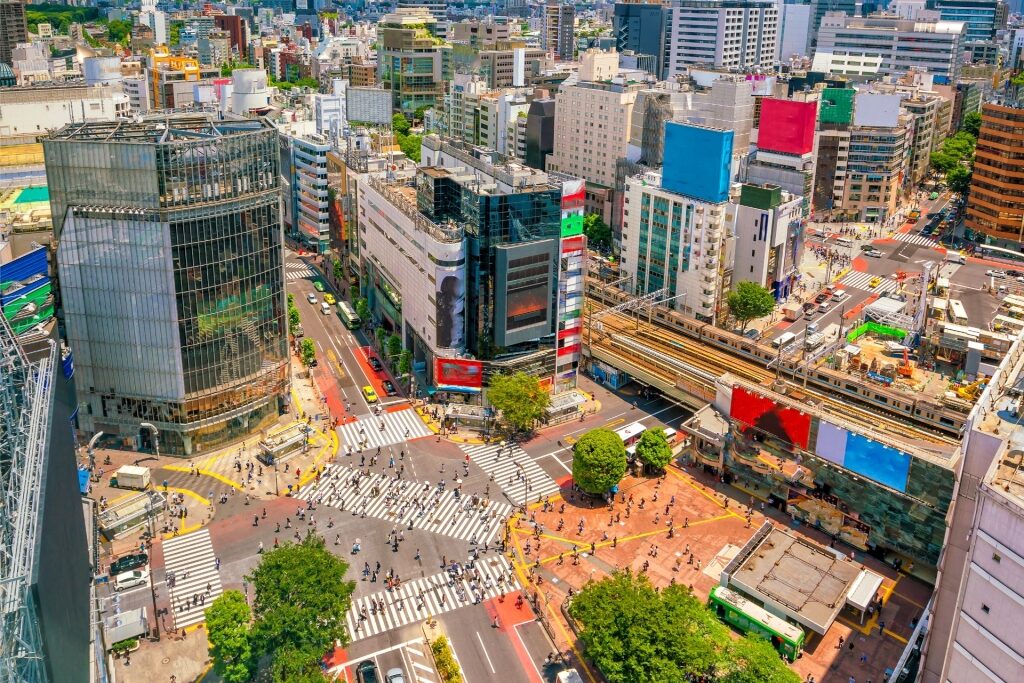
Shibuya Crossing, Tokyo
Mount Fuji, with a snapshot against a backdrop of springtime cherry blossoms or vibrant autumn leaves, has got to be at the top of any photographer’s “famous landmarks in Japan” list.
Bustling Shibuya Crossing in Tokyo, Itsukushima Shrine’s “floating” torii gate, or the more Zen-focused Arashiyama Bamboo Grove are also amazing places to take photos.
Are they open all year round?
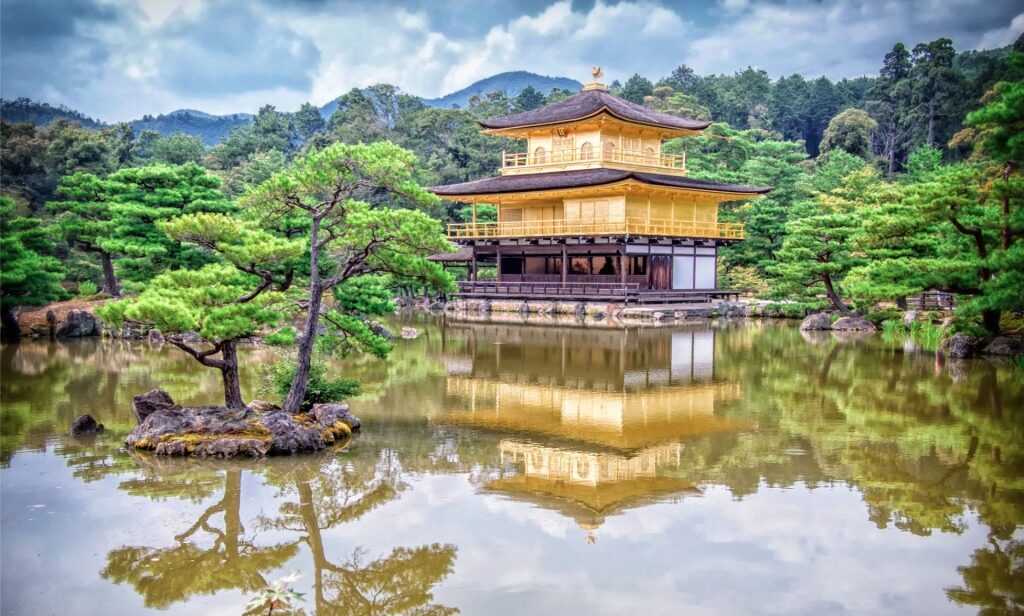
Kinkaku-ji Temple, Kyoto
Most of Japan’s major landmarks are open year-round, although some museums, gardens, and castles close for a few days around the busy New Year’s period, as it’s a hectic time for domestic travel.
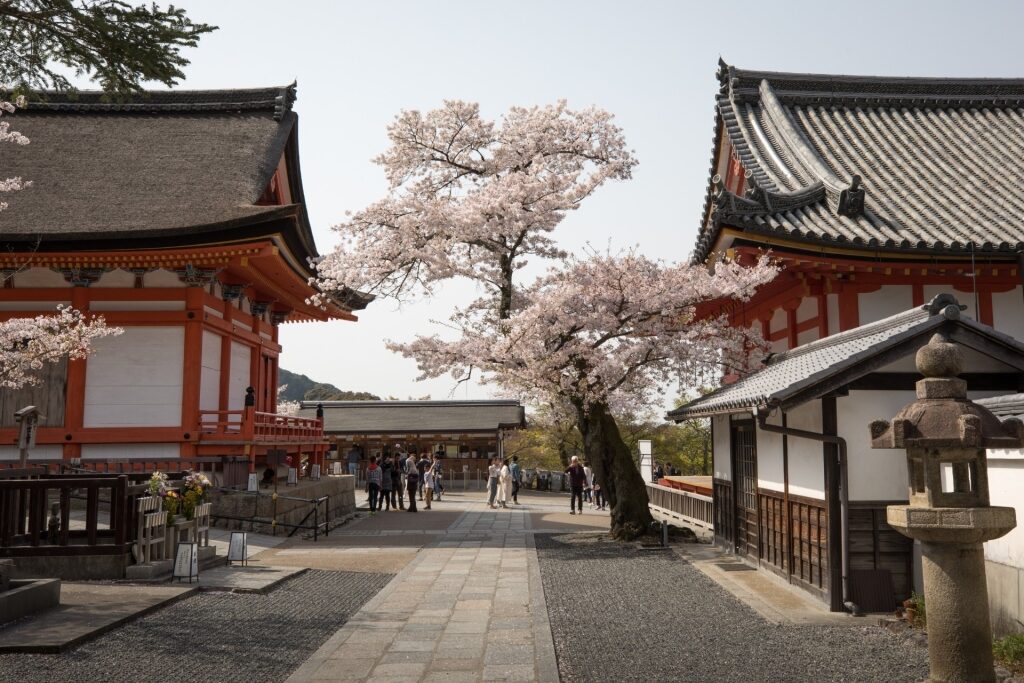
Kiyomizu-dera Temple, Kyoto
Inspired by these famous landmarks? Browse our cruises to Japan to find the perfect itinerary to take in the sights of this amazing country.
